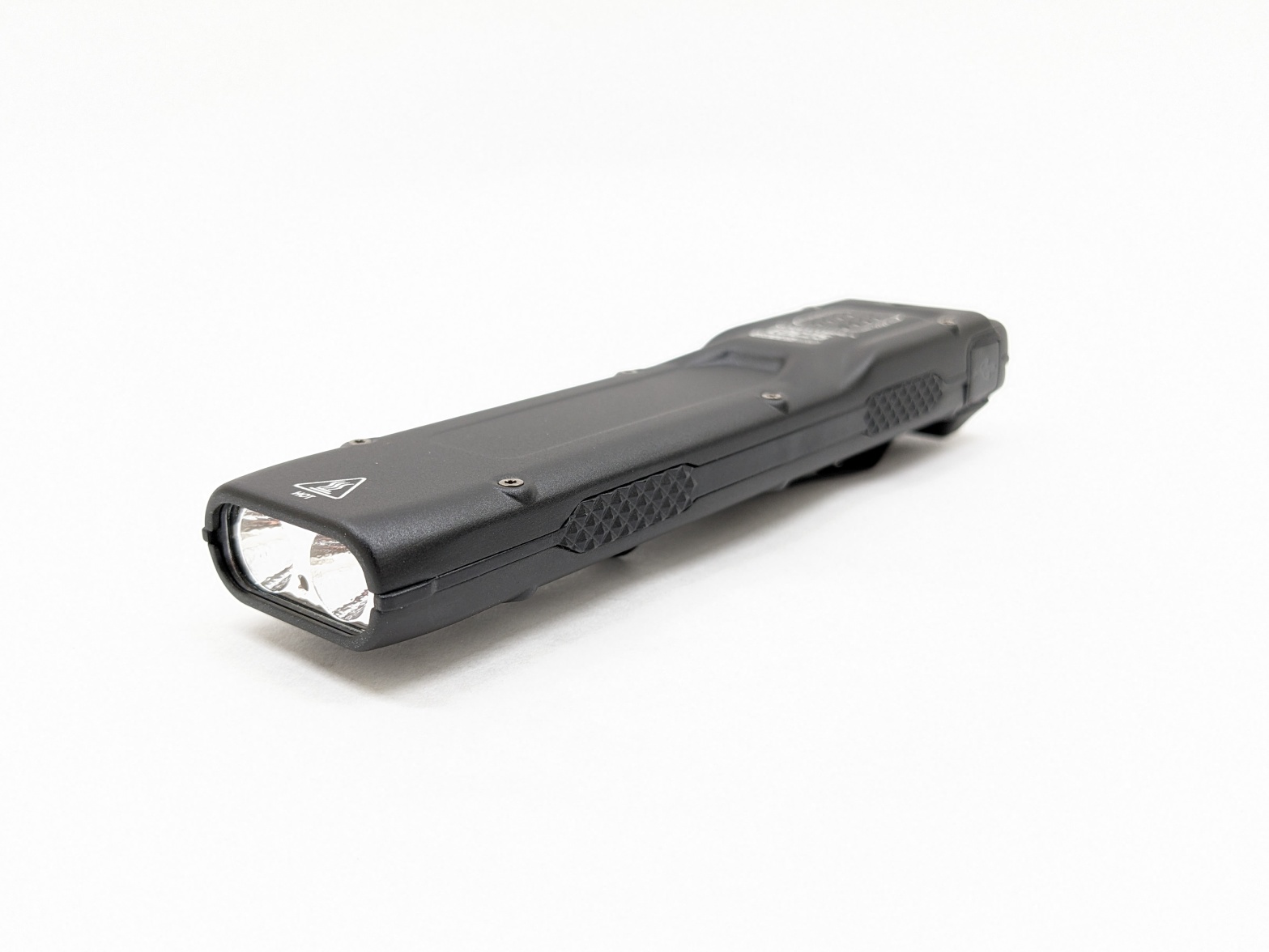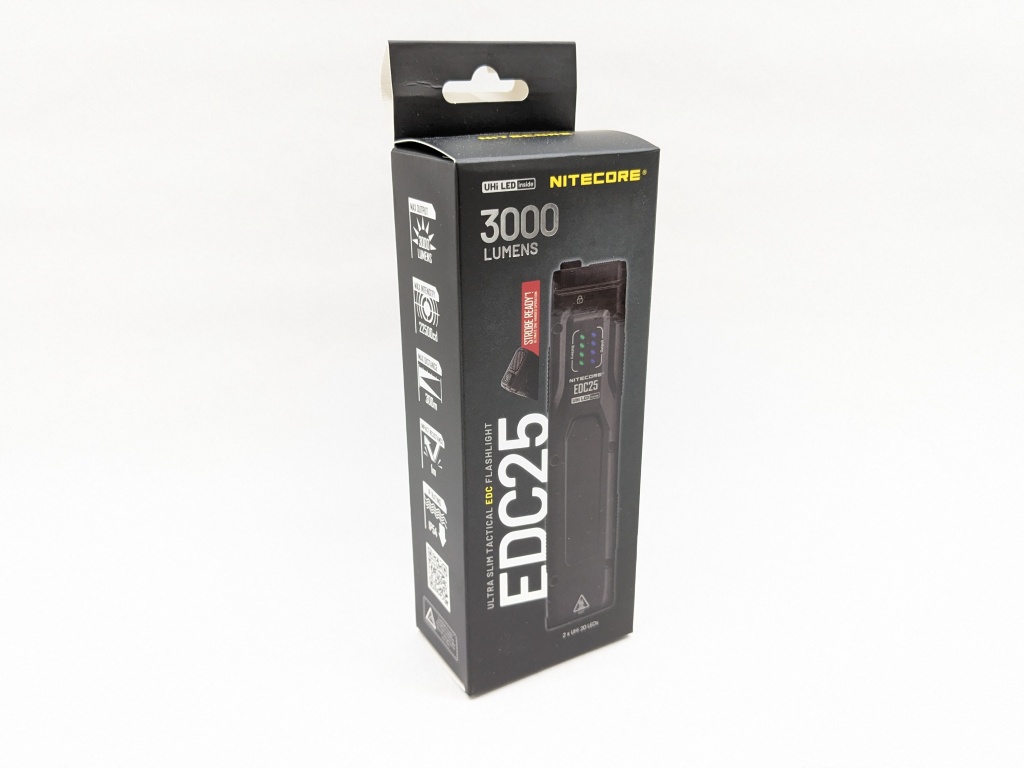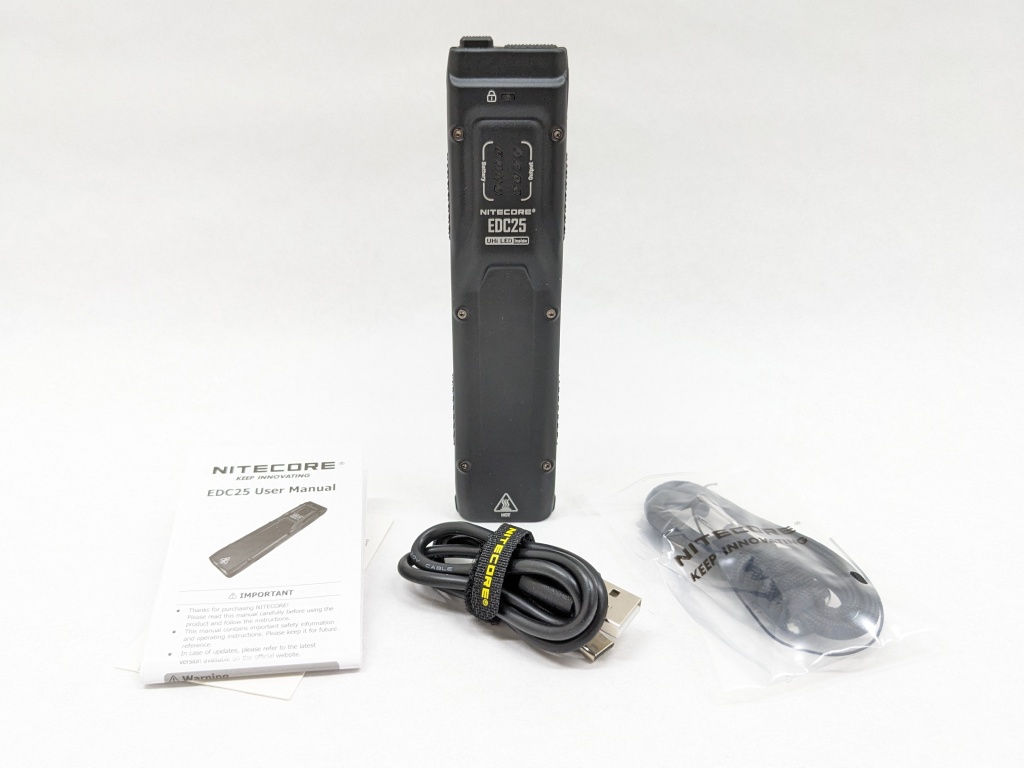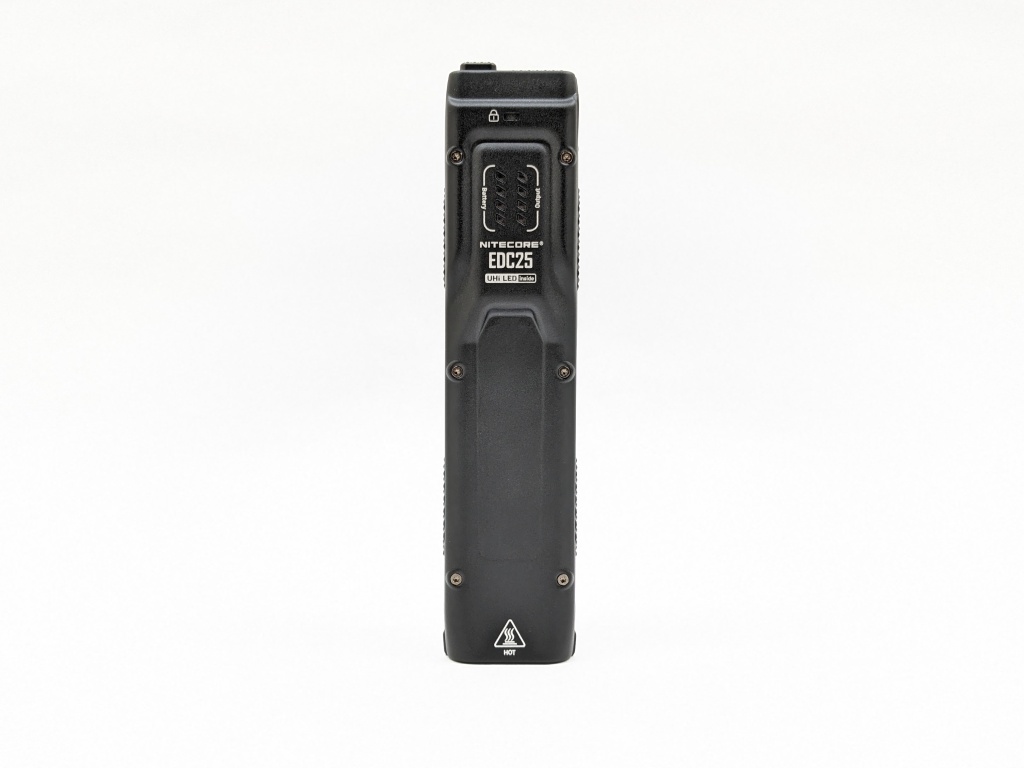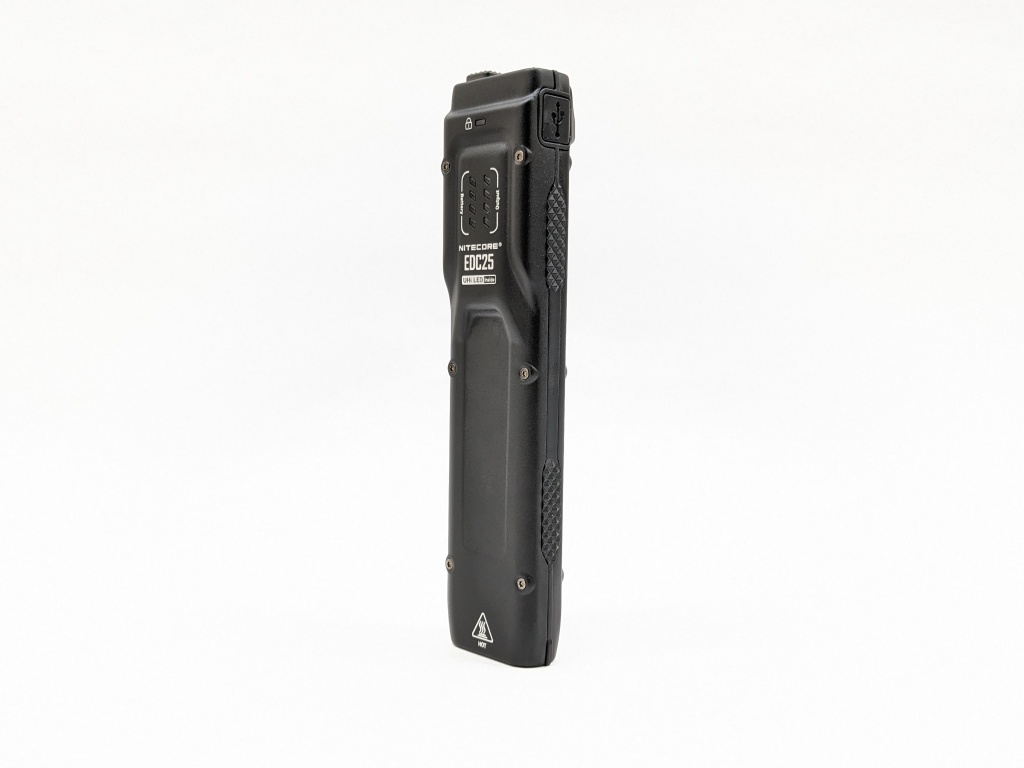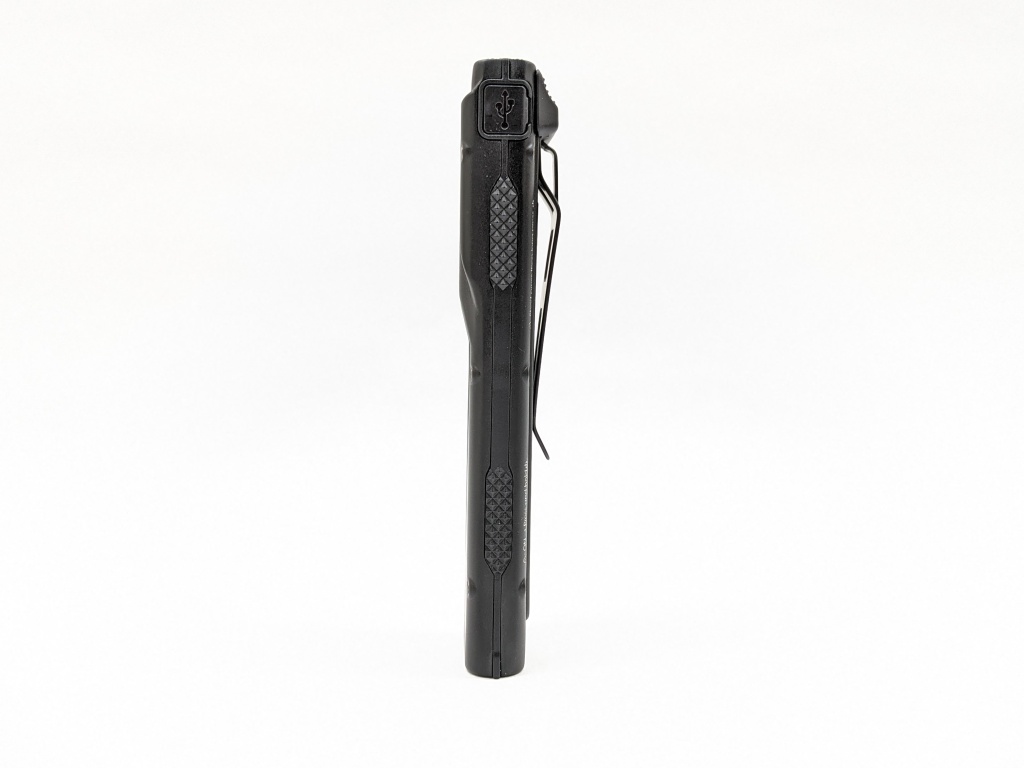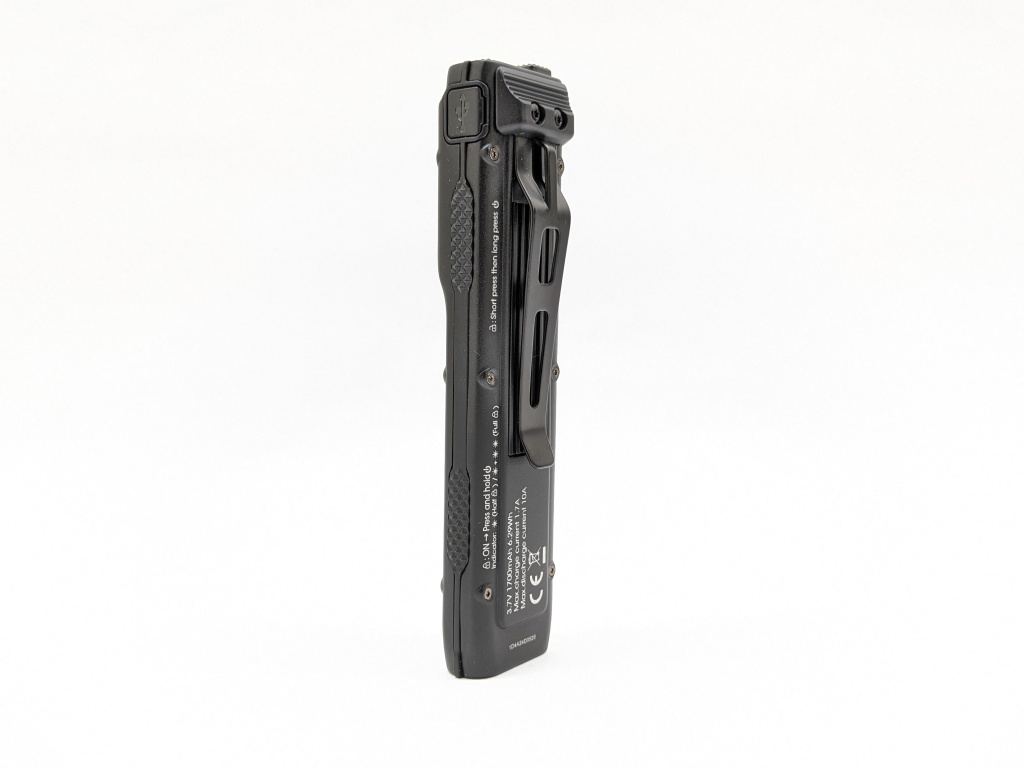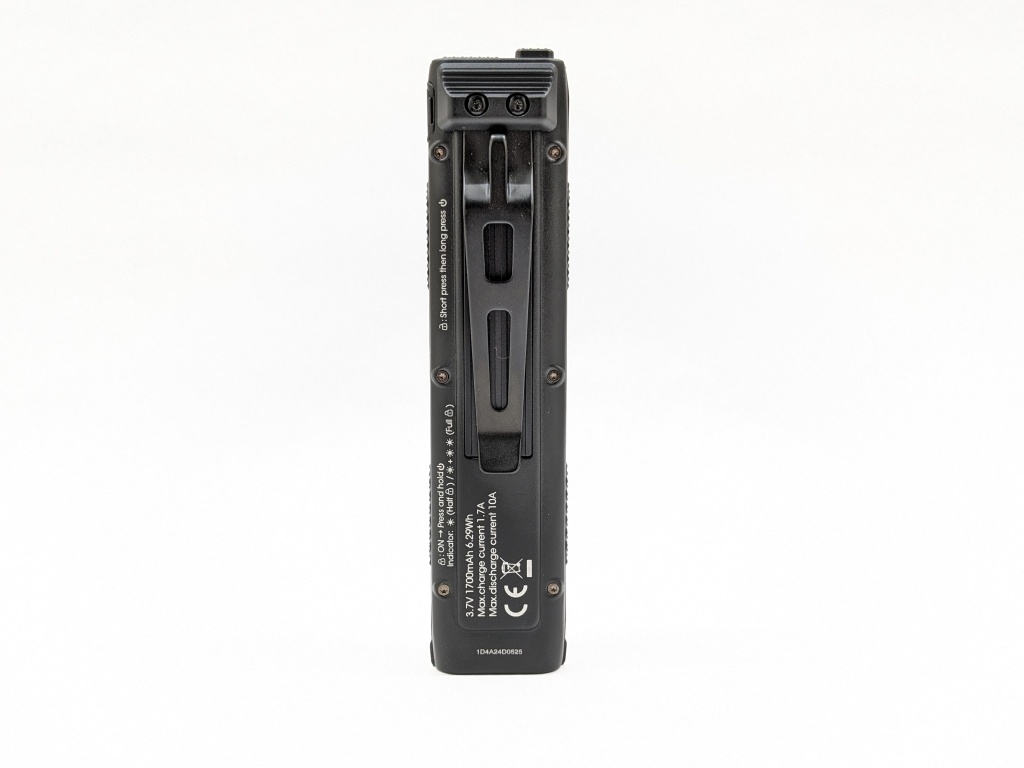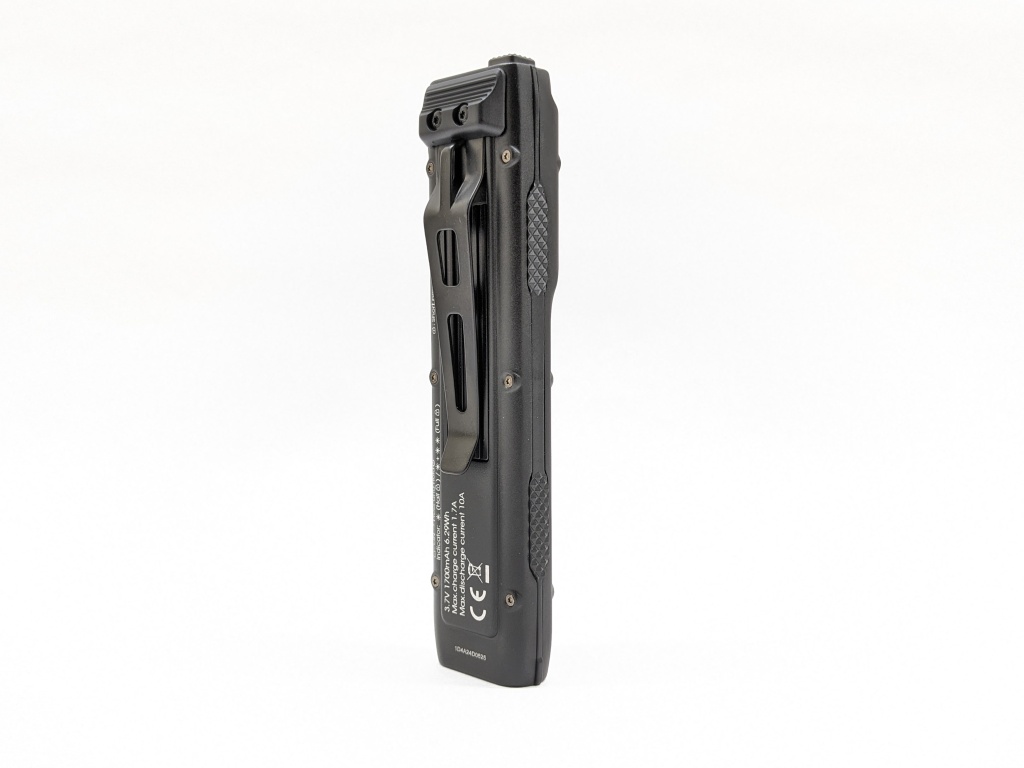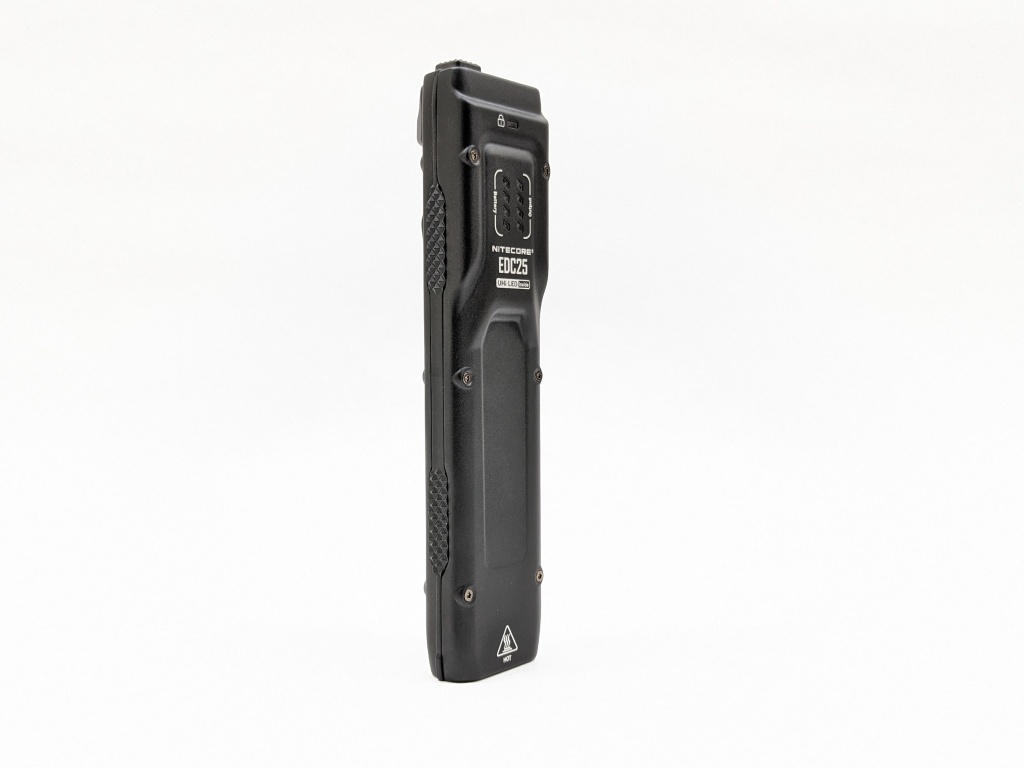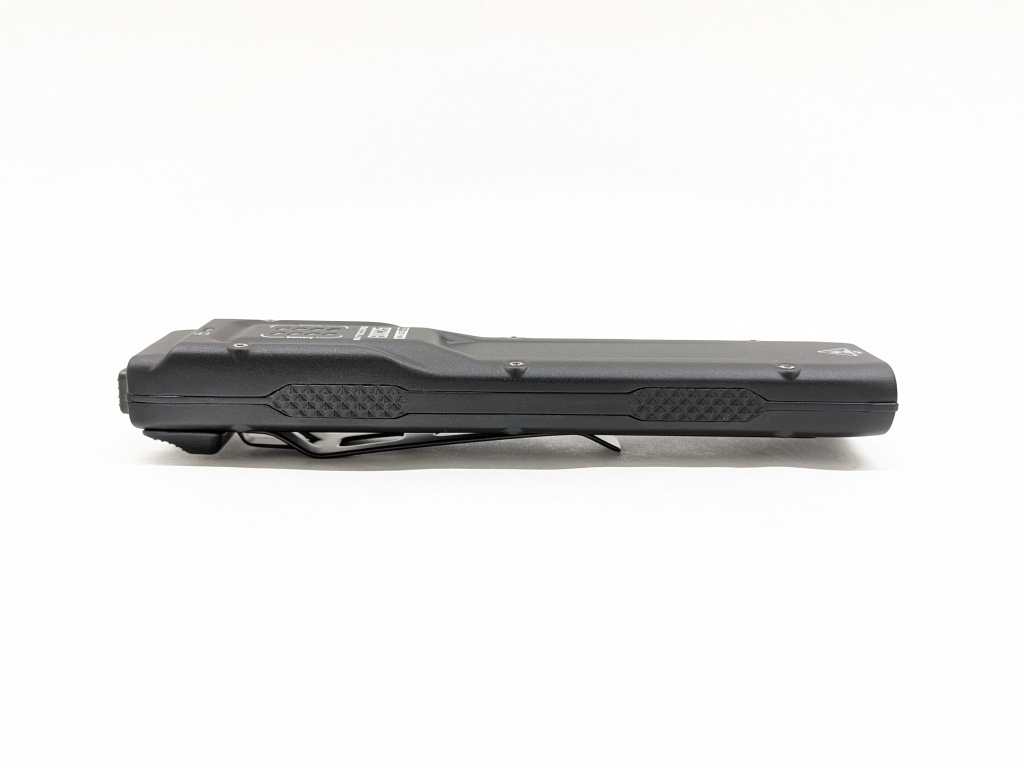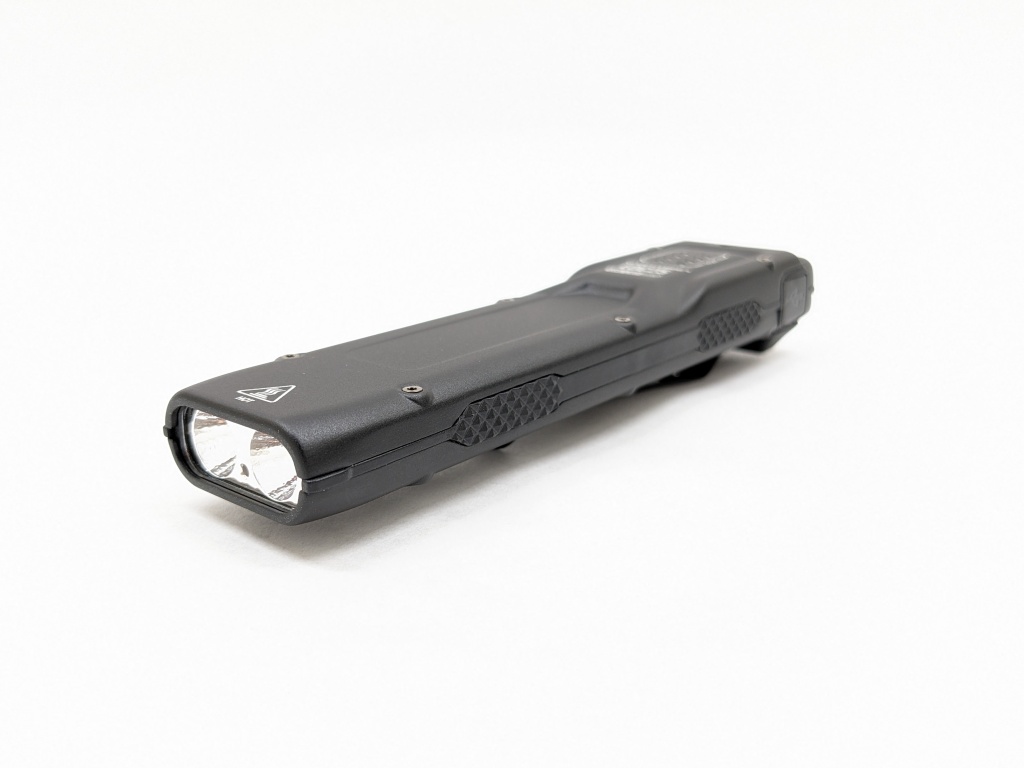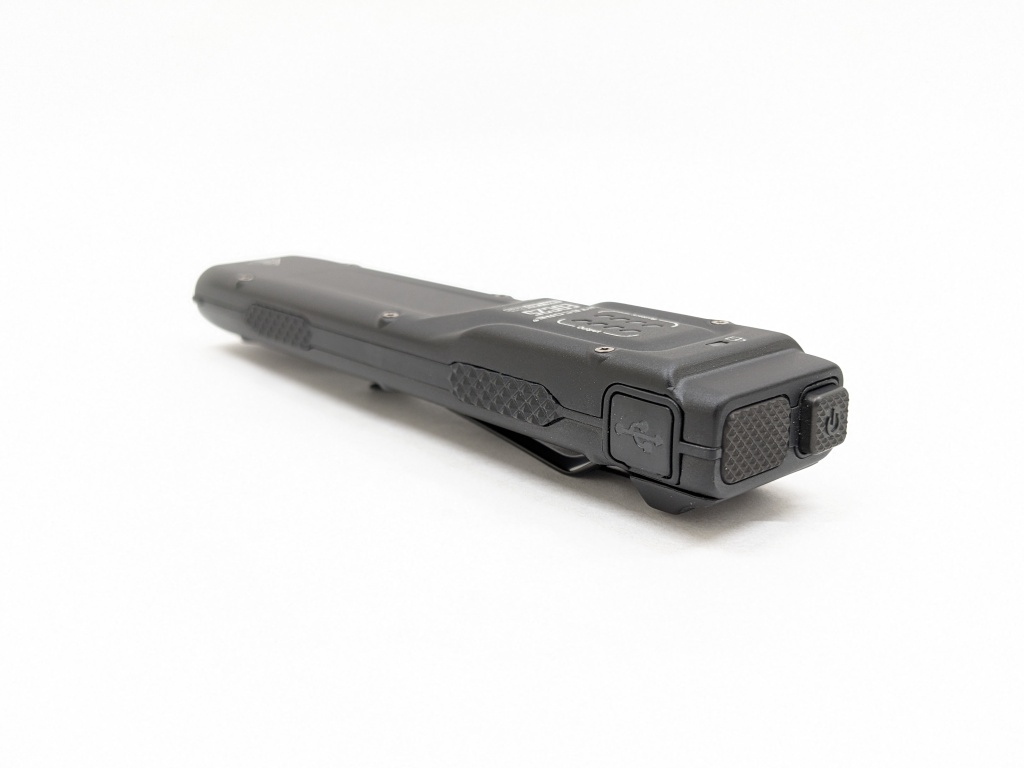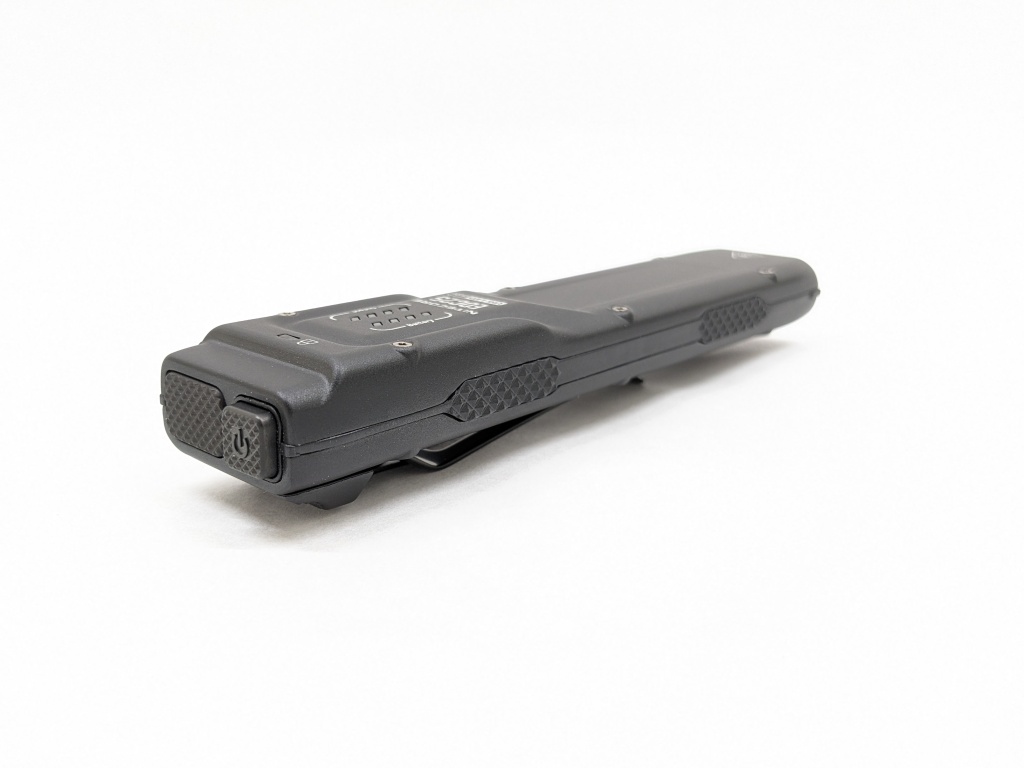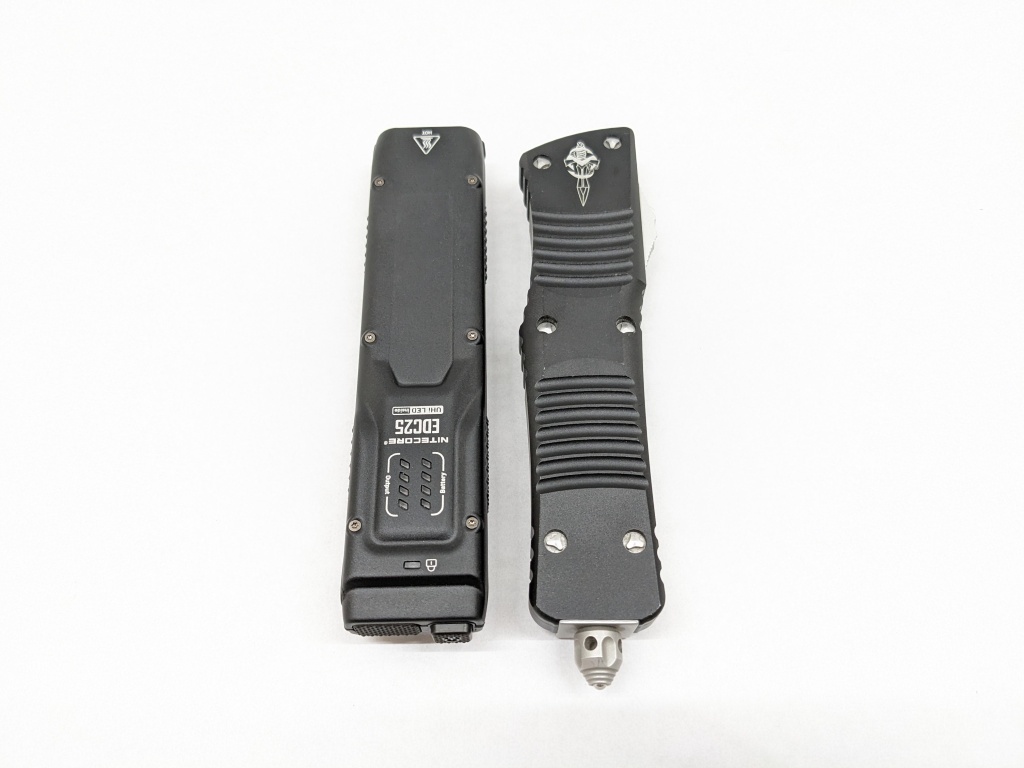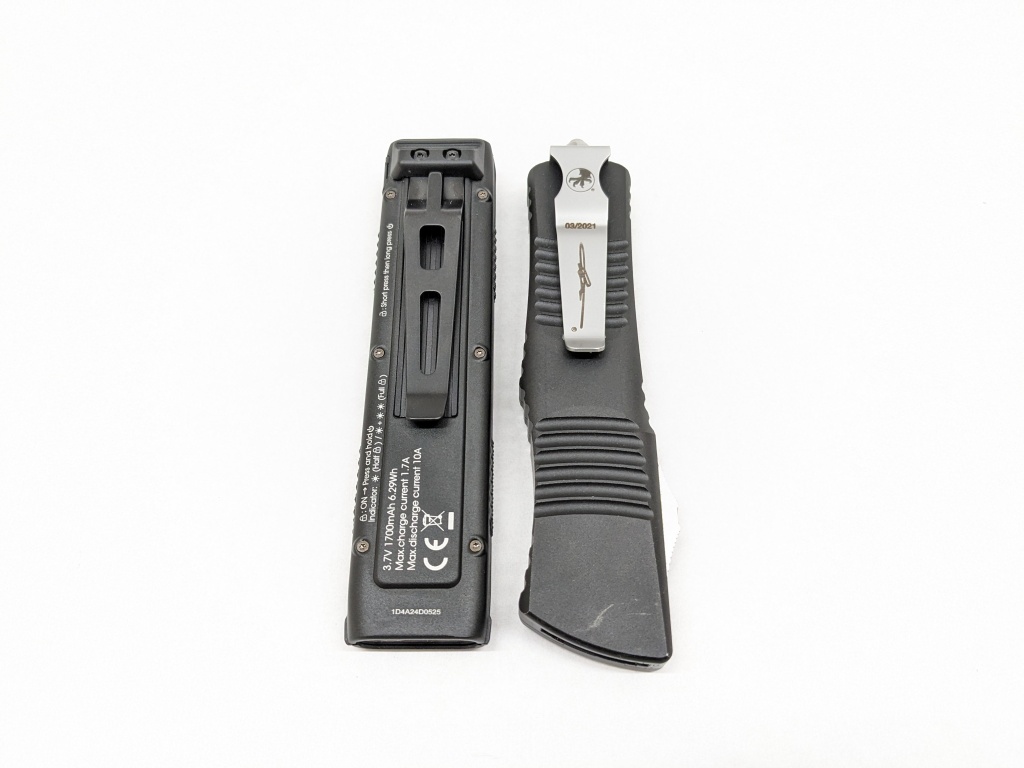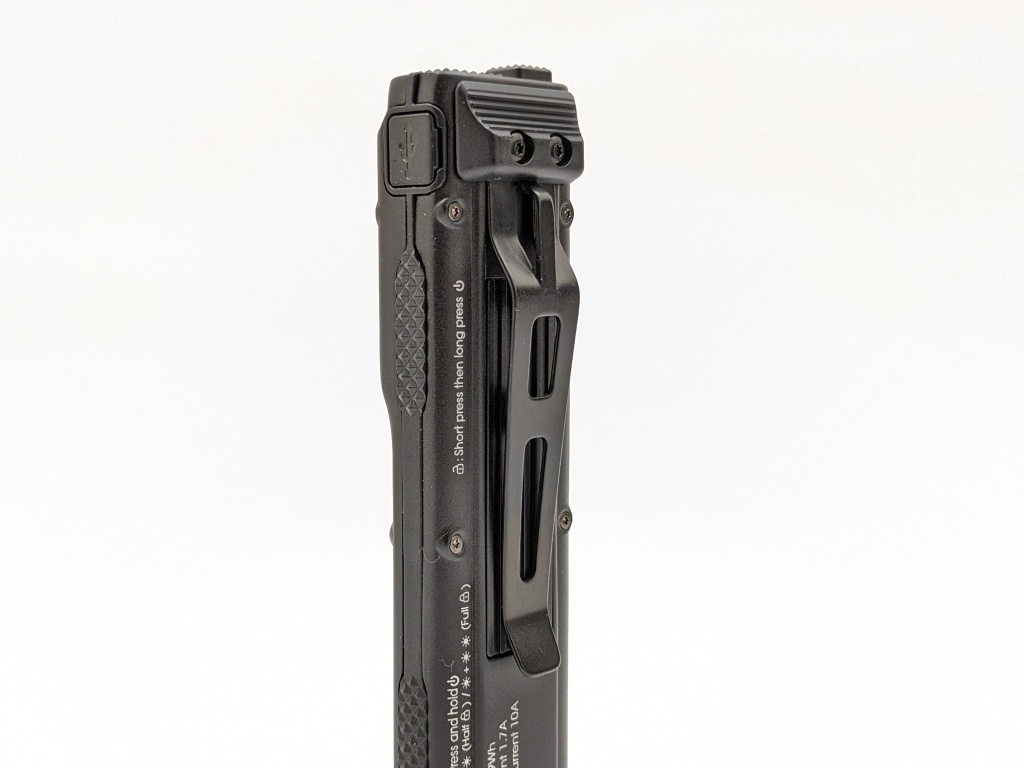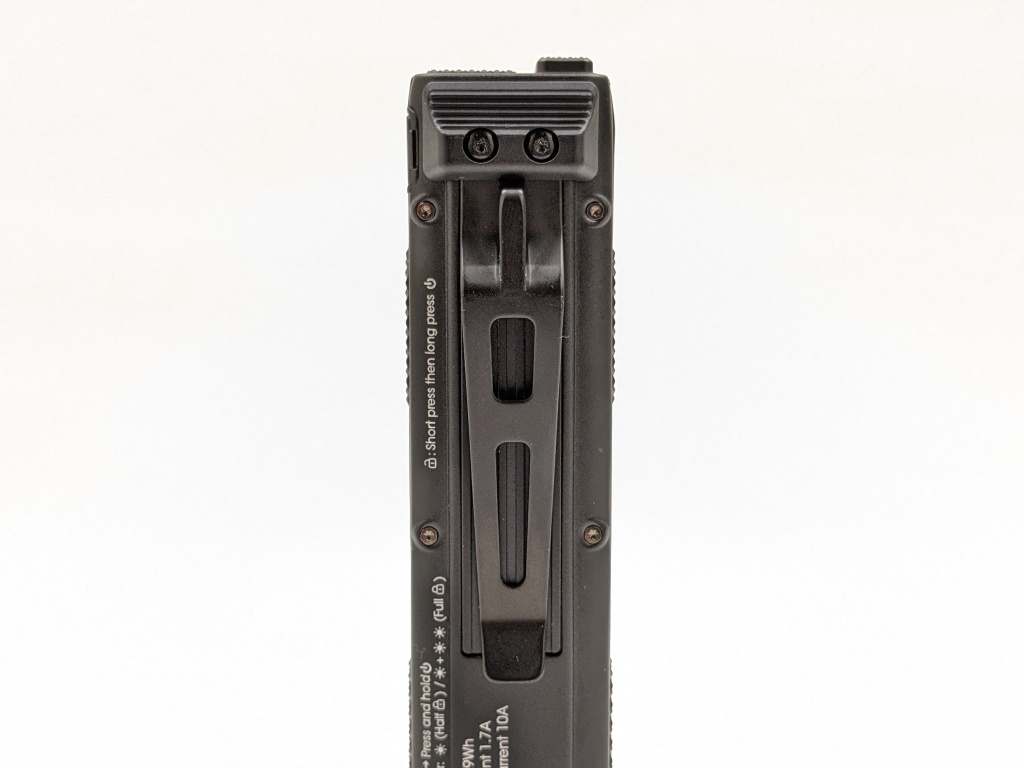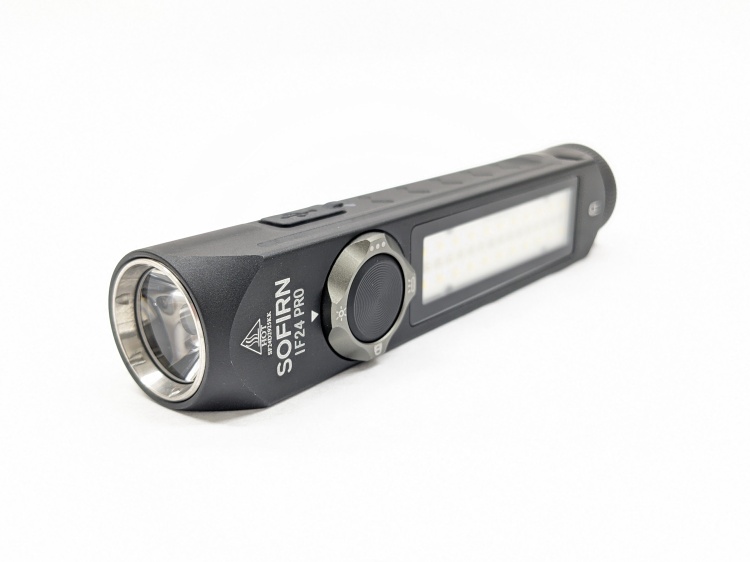Contents
- Pricing & Availability
- What comes in the box?
- Design & Construction
- Size & Measurements
- User Interface
- Emitter & Beam
- Mode Chart
- Runtime
- Driver & Regulation
- Switch
- Carry & Ergonomics
- Batteries & Charging
- Competition
- Conclusion
Pricing & Availability
Nitecore sent me this light in exchange for an honest review. Here is the official product page where you can see current pricing.
What comes in the box?
The box is Nitecore’s typical black printed retail box with yellow accents. There’s a vacuum-formed plastic insert inside to hold the contents securely. Inside is:
- The light itself
- User manual
- USB A-to-C charging cable
- Wrist lanyard
Design & Construction
EDC25’s main feature is its thin, flat design. It’s about the same size and shape as a large pocket knife. While most of it is thinner than your average EDC flashlight, it is still fairly large.
Build quality is fine. It doesn’t feel as high-quality as the price tag would suggest. It appears to be a stamped aluminum sandwich held together with Torx screws. Thanks to that stamped aluminum and the pouch-style built-in battery, it’s very lightweight for its size. There’s no thread lock on any of the screws so it’s easy to remove the clip and bend it back into shape if it gets snagged on something. It’s also worth noting that it’s only IP54 rated, not IP67/IP68 like most quality flashlights.
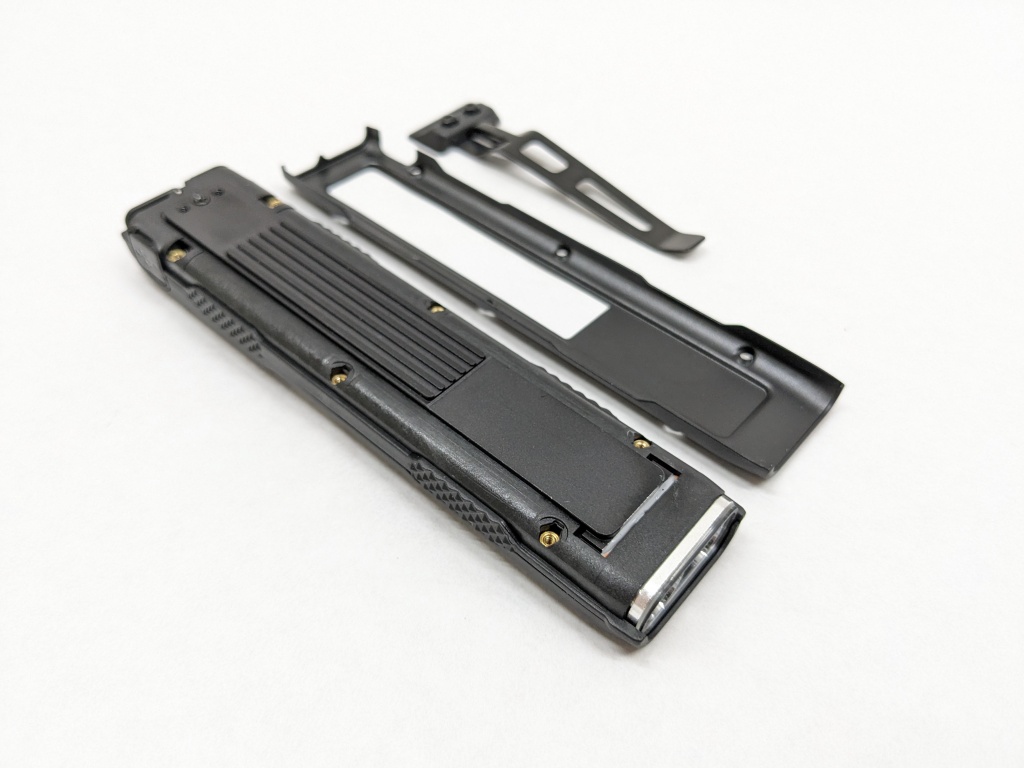
For heat dissipation, there’s an aluminum bar coming off the MCPCB that leads to some heatsink fins under the pocket clip. The body of the light gets warm too, but that aluminum bar provides a large heatsink for heat to go when you use the insanely bright Turbo mode.
Size & Measurements
Nitecore EDC25| fake Microtech Combat Troodon
Olight Warrior 3S | Nitecore EDC25 | Nitecore EDC33 | Nitecore EDC35 | Mini Maglite
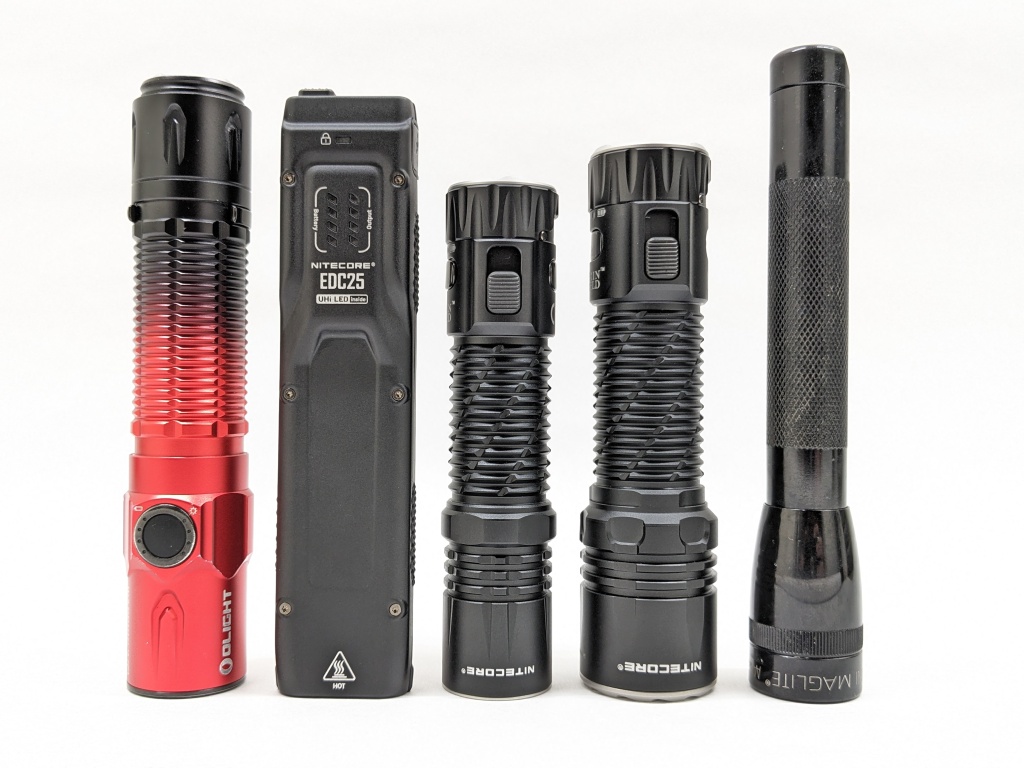
| Measurement | Measured (mm) |
|---|---|
| Width | 31.4 |
| Thickness (toward the head) | 14.4 |
| Thickness (toward the tail) | 17.0 |
| Thickness (max) | 22.4 |
| Length (including switch) | 136.6 |
| MCPCB Size | custom |
| Pocket Clip Screw Spacing | 8.3 |
| Weight (g) | 106 |
User Interface
This is a unique and well-designed UI, and that impresses me. Often, when a flashlight maker tries something new with a switch or UI design, it’s cumbersome. Nitecore did an excellent job of innovating and keeping it intuitive and usable.
This light uses a two-stage electronic tail switch I’ll call the “main” switch and a separate momentary switch called the “customizable switch”.
| State | Switch | Action | Result |
|---|---|---|---|
| Off | Main | Full-Press | On |
| Off | Main | Half-Press | Momentary “Ultra-low” |
| Any (except full lockout) | Customizable | Press and hold | Momentary Turbo or Strobe |
| Turbo or Strobe | Main | Full-Press | Toggle between Turbo and Strobe |
| On | Main | Half-Press | Cycle mode (“Ultralow”-Low-Med-High) |
| On | Main | Half-press-and-hold until the lockout indicator blinks once | Half-lockout |
| On | Main | Half-press-and-hold until the lockout indicator blinks twice | Full-lockout |
| Lockout | Main | Full-press, release, Full-press, and hold | Unlock |
What they got right:
- There’s a dedicated Turbo/Strobe button. I love being able to quickly, instantly, and momentarily access Turbo without needing a specific series of clicks. It’s a great feature, and it’s nice that you can choose between Turbo or Strobe.
- There are 5 brightness levels, which is just the right amount. Enough to have options but not so many that it’s cumbersome to use.
- Turbo and Strobe are not memorized. They have a dedicated switch, so you can access them quickly without overriding your memorized mode.
- There’s a shortcut to the lowest mode. Half-pressing the main switch will momentarily activate the lowest mode. That’s great for situations where you don’t want to cycle through High to get down to “Ultralow”.
What they got wrong:
- “Ultralow” is not ultra-low. It’s 15 lumens. I expect an EDC flashlight to have a proper moonlight mode of 1 lumen or less.
- There’s no way to jump from “Ultralow” straight to low. If you half-press into “Ultralow” and then do a full-press, it should go into Low, but it doesn’t do anything.
- Half-lockout mode seems pretty goofy and unnecessary to me. It doesn’t really get in the way, but I want a light to either be locked or not.
Emitter & Beam
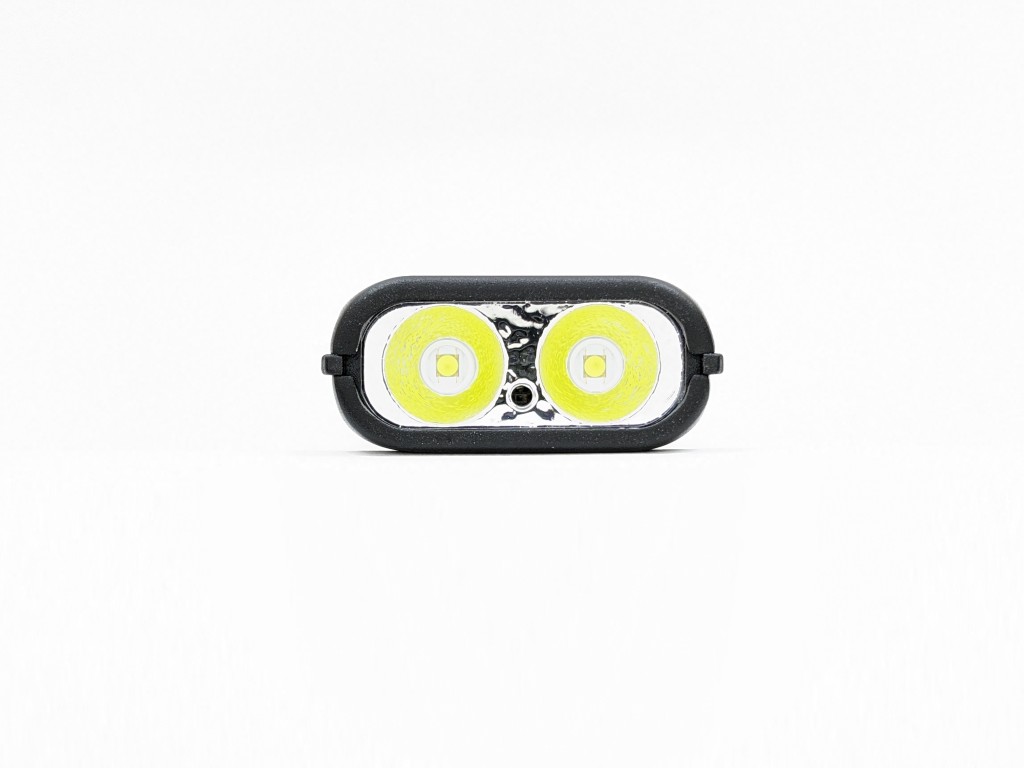
EDC25 uses two NiteLab UHi-20 LEDs. I don’t think they’re exclusive to Nitecore, but I don’t think they’re branded “NiteLab” by any other makers. UHi-20 is a domeless emitter with a tiny die, so it’s got great intensity. The two LEDs each sit in their own orange-peel reflector and there’s a small proximity sensor between them. These offer a lot more throw than the SST40 LEDs used in Nitecore’s EDC27 model.
The proximity sensor detects if the light is close to an object when it’s turned on. If so, it will dim the light until the obstruction is removed. That only works if the light is already obstructed when you turn it on. If you turn it on and then put something in front, the sensor won’t do anything. I find this works well at protecting pockets without getting in the way of normal use.
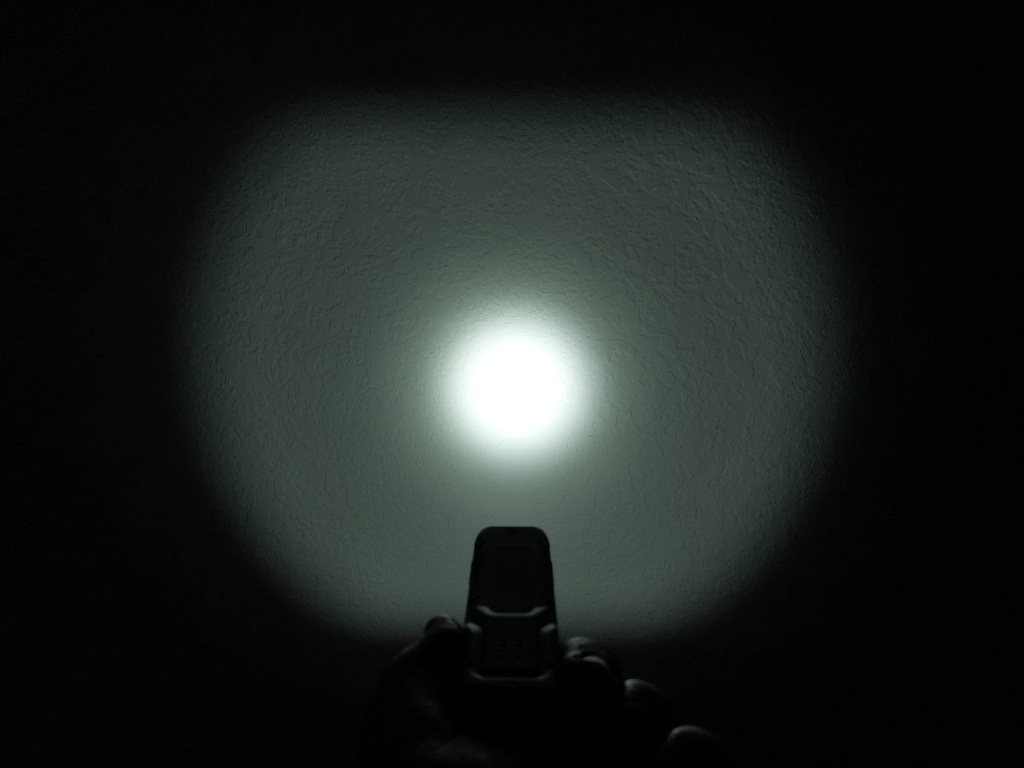
The beam has a good general-purpose profile, not too narrow, nor too wide (9.3 cd/lm). There are two flat spots in the spill from the rectangular bezel slightly blocking the beam.
In the beamshots below, camera settings are fixed and the wall is 2.8M away.
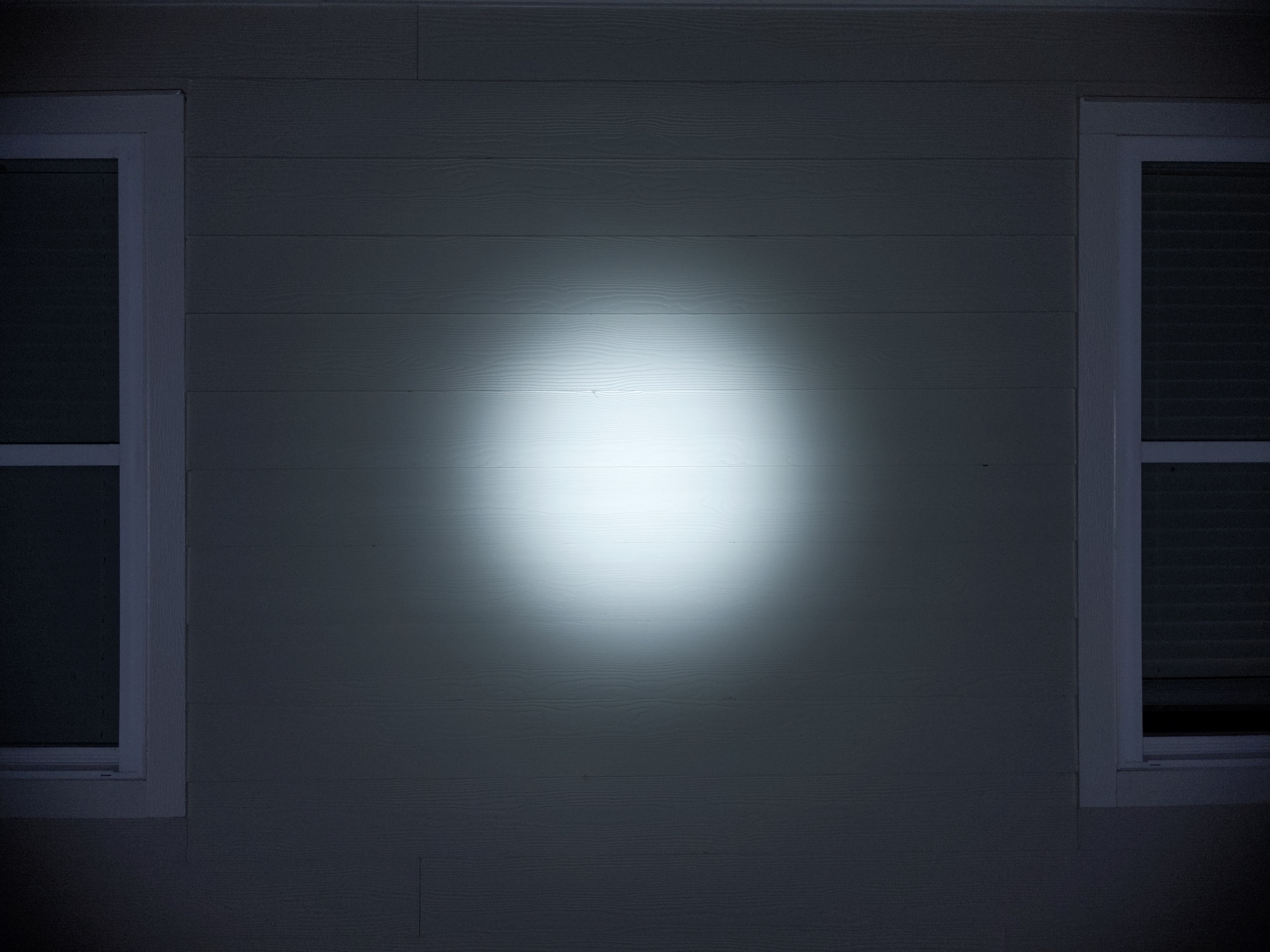
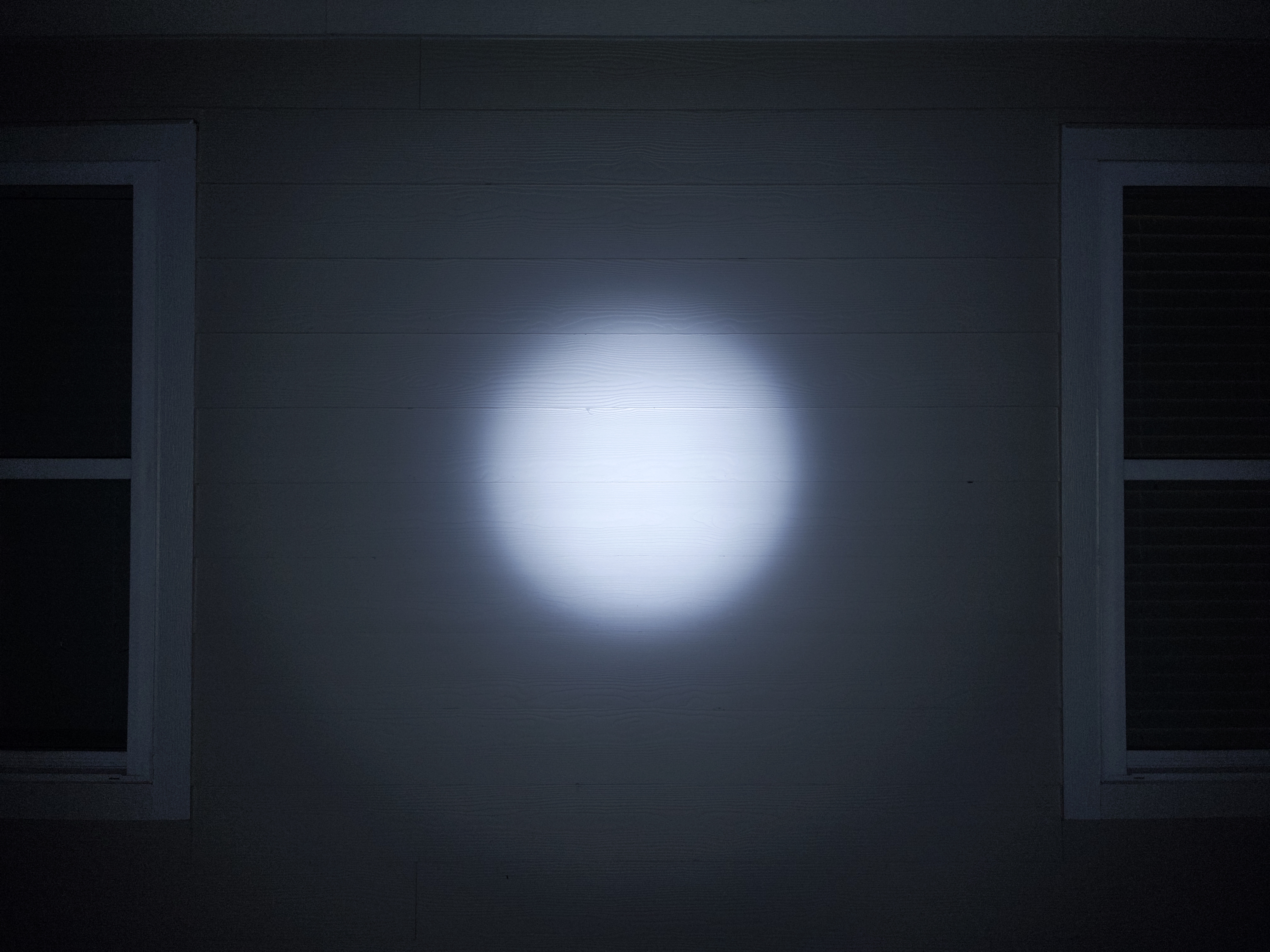

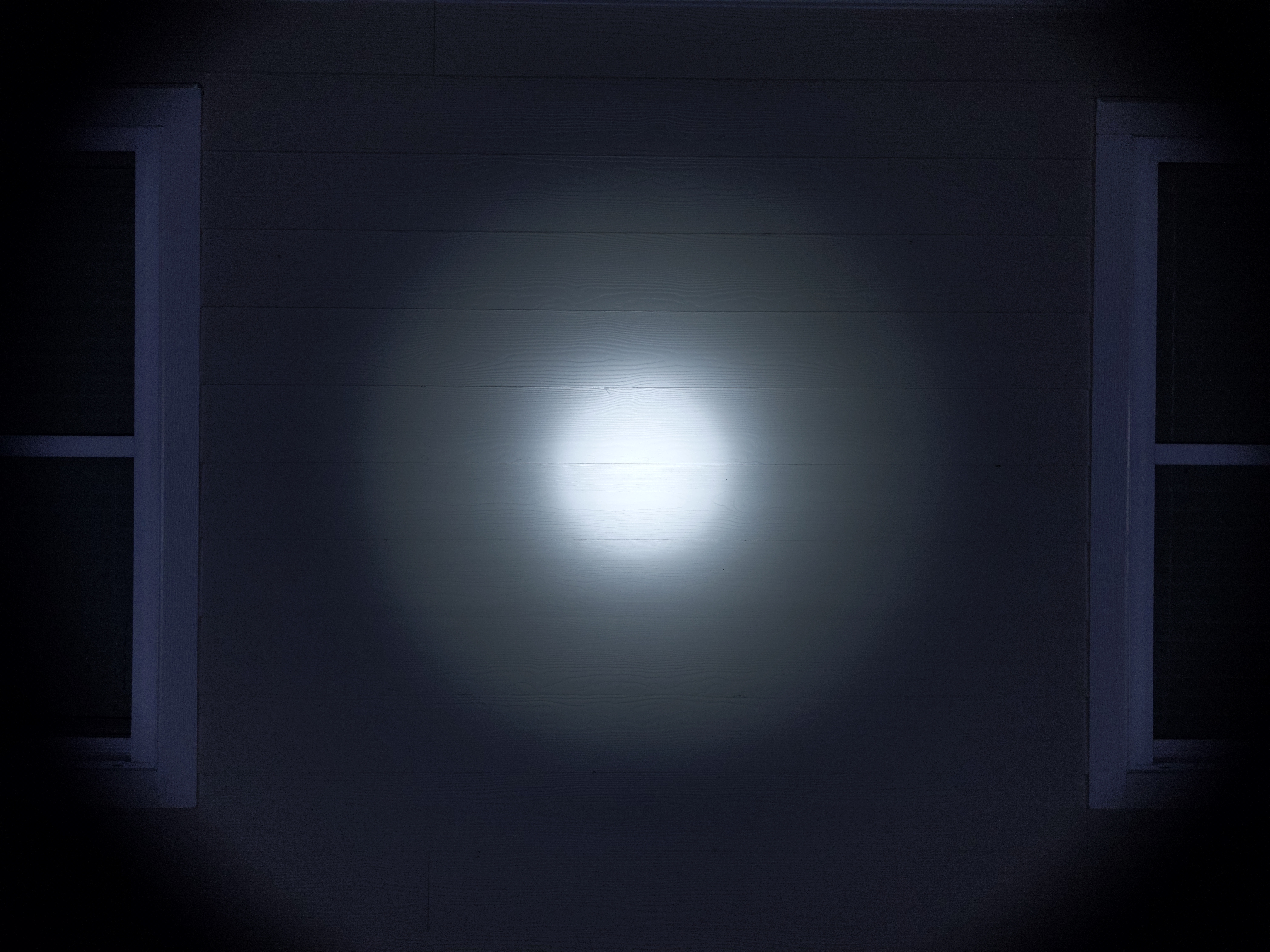



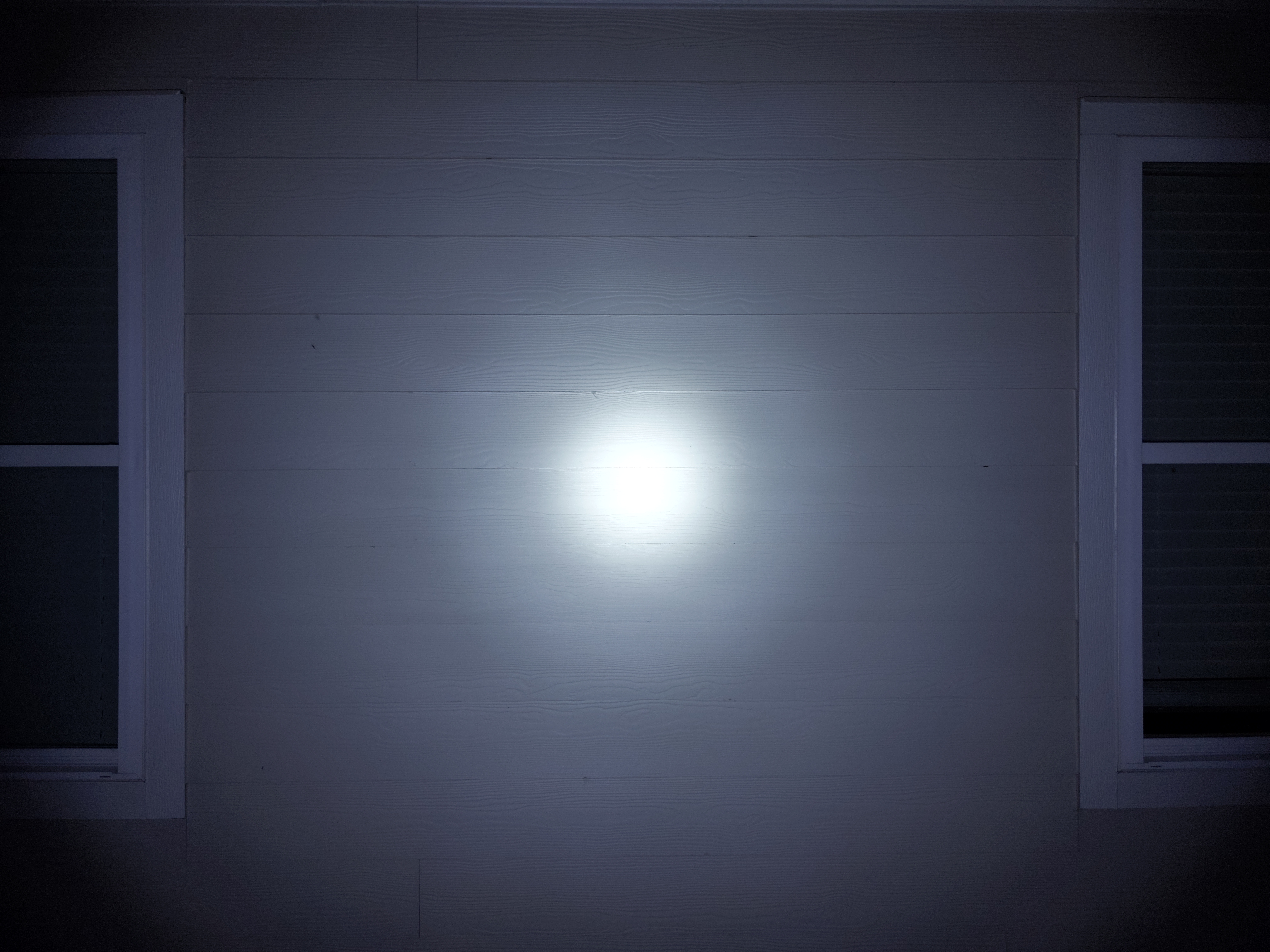
In the beamshots below, camera settings are fixed, the basketball goal to the right of the hotspot is 39M away, and the power pole in the center is 185M away.
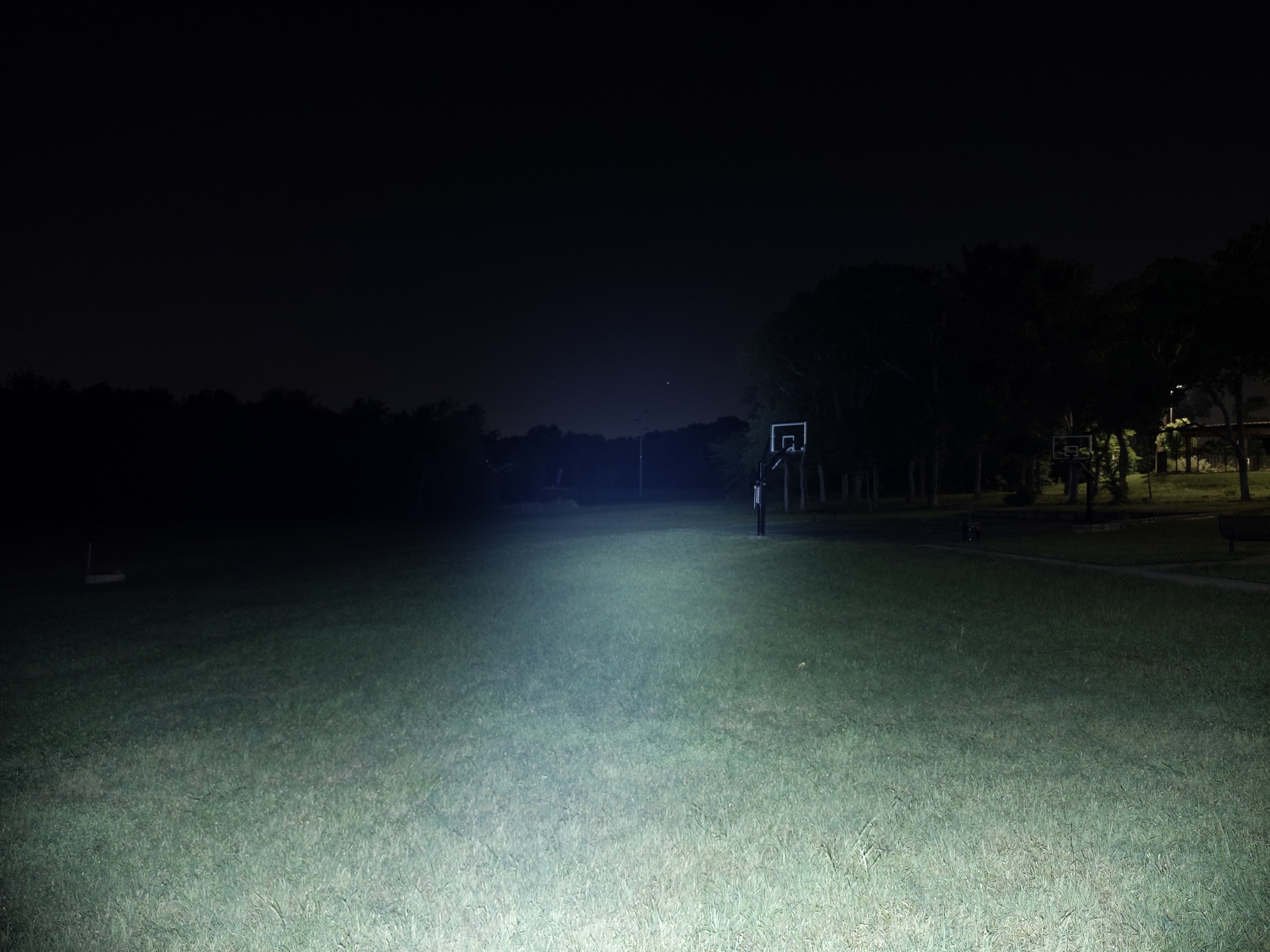
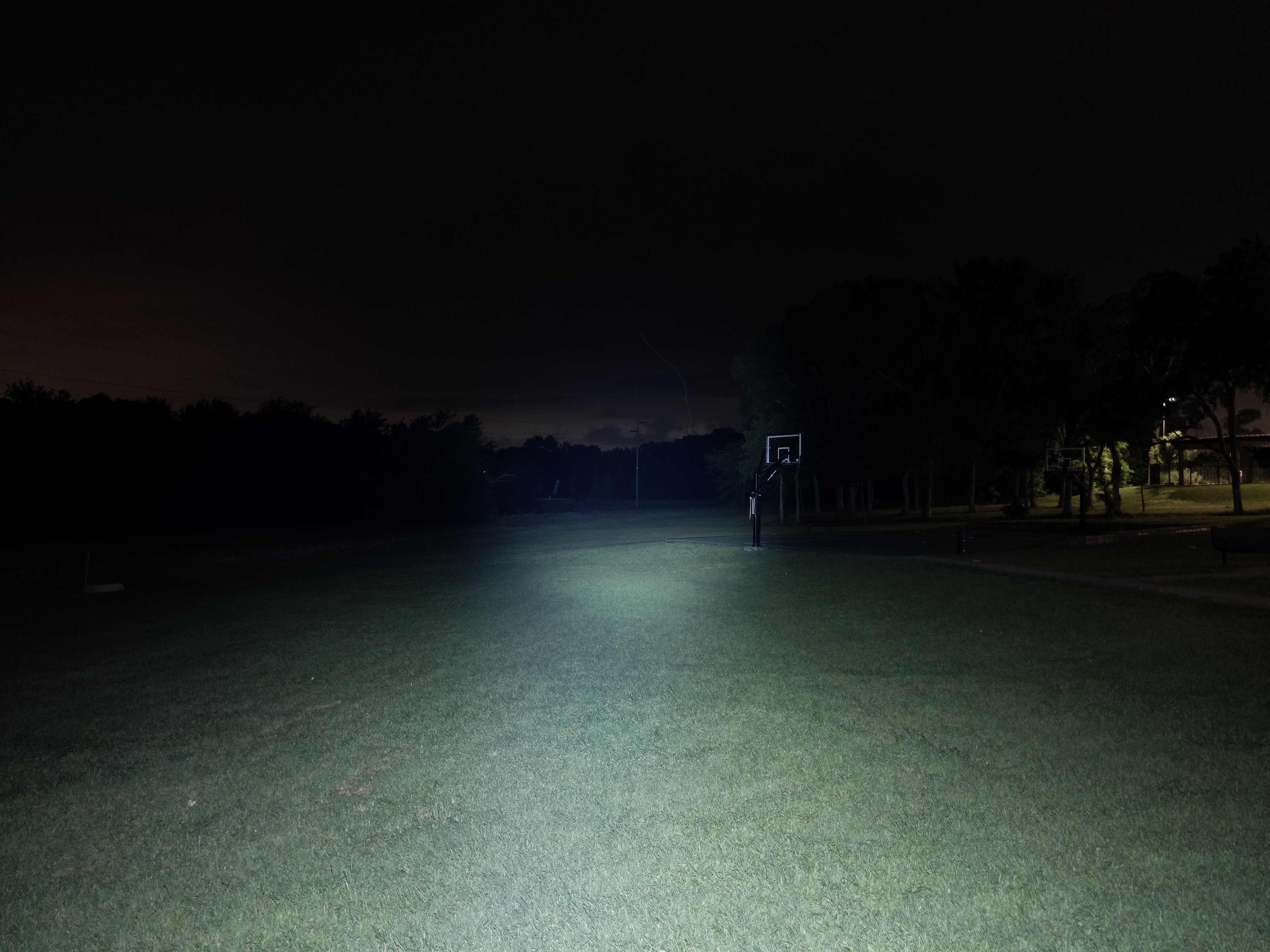

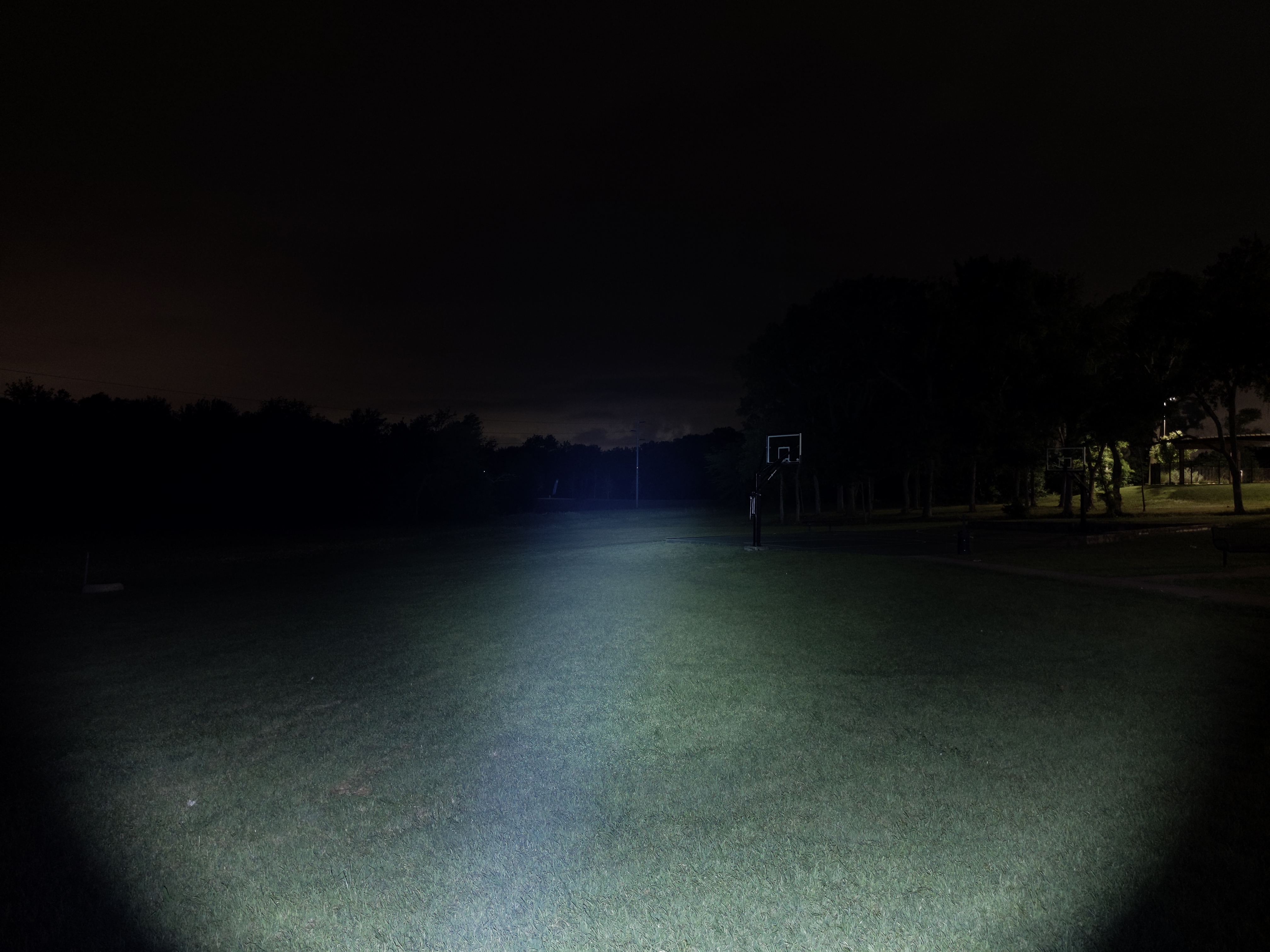

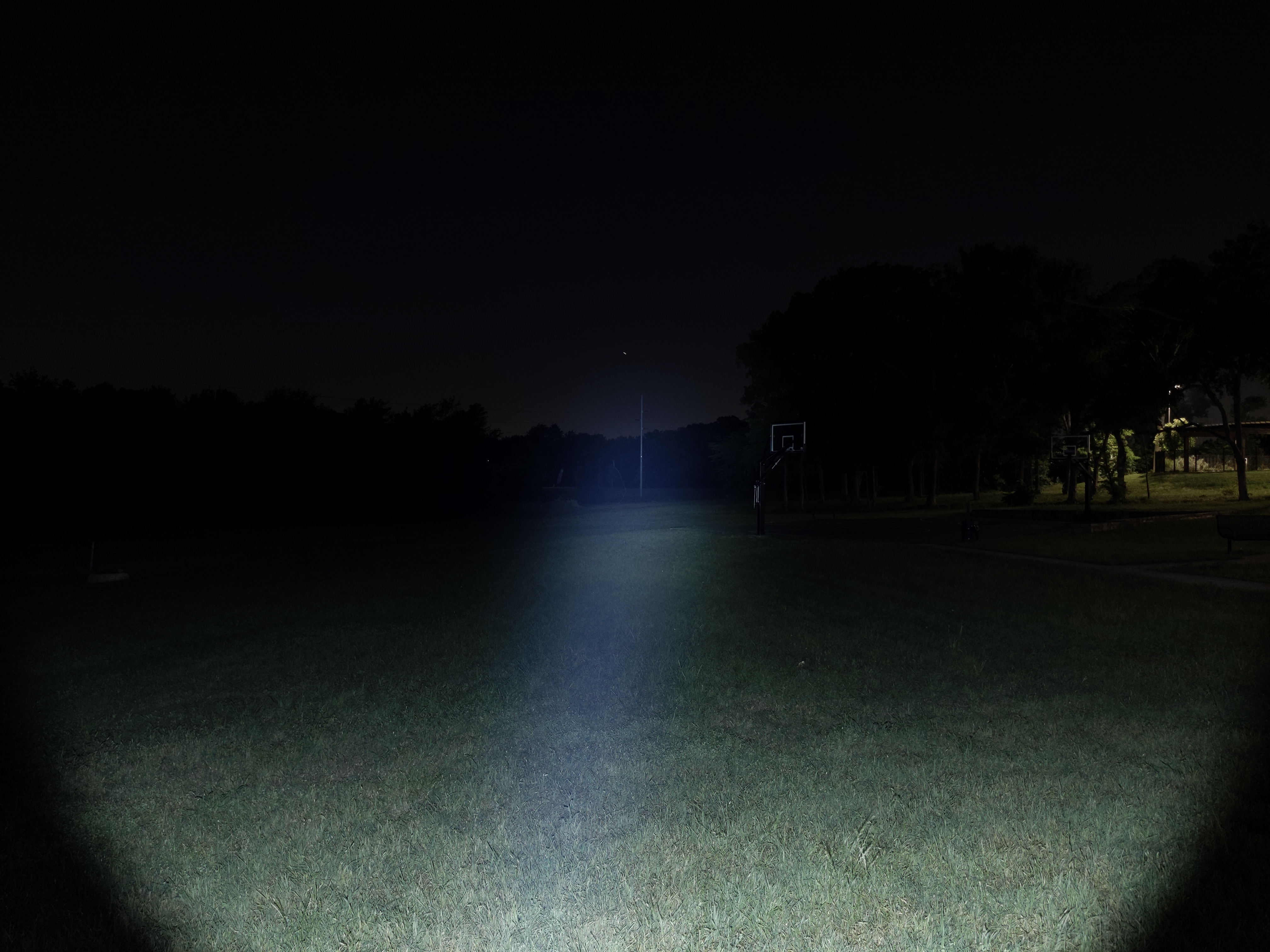

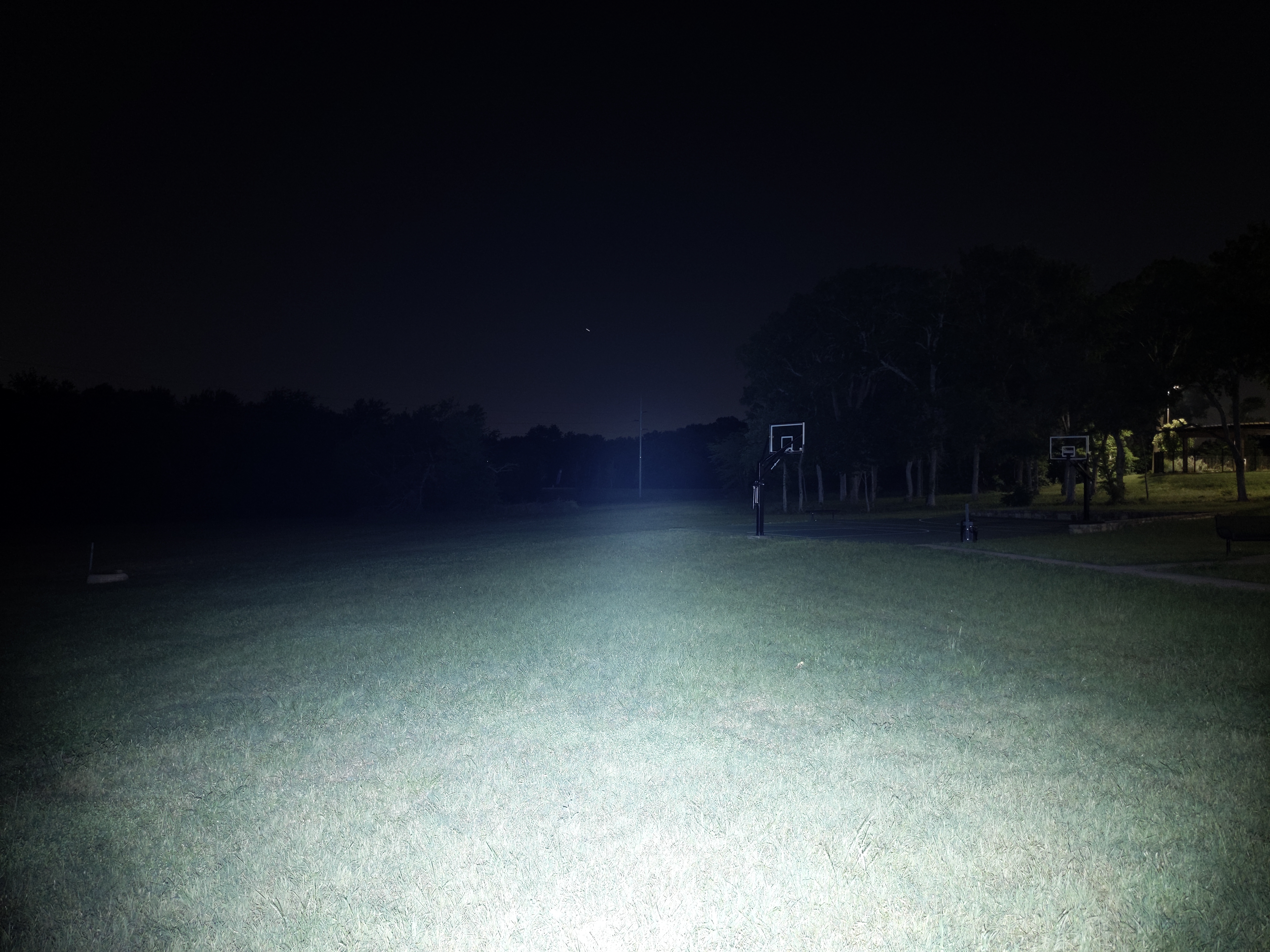
Mode Chart
Disclaimer: All of my measurements are taken at turn-on. Lumen measurements were taken on a Texas Ace 3.5″ Lumen Tube. A candela measurement was taken at 10 meters with an Opple Light Master III on the highest brightness, and other candela figures were calculated relative to that. CRI, CCT, & DUV data were taken for each mode from a few feet away at the center of the hotspot with the Opple Light Master and Waveform DUV Calculator. Runtime tests were performed with the Ceilingbounce app on my smartphone. These tests were performed with a fully charged included battery unless otherwise specified. I cannot measure moonlight directly, so moonlight readings are calculated based on the brightness relative to the next-lowest mode. None of this is professional equipment, so take these measurements with a grain of salt.
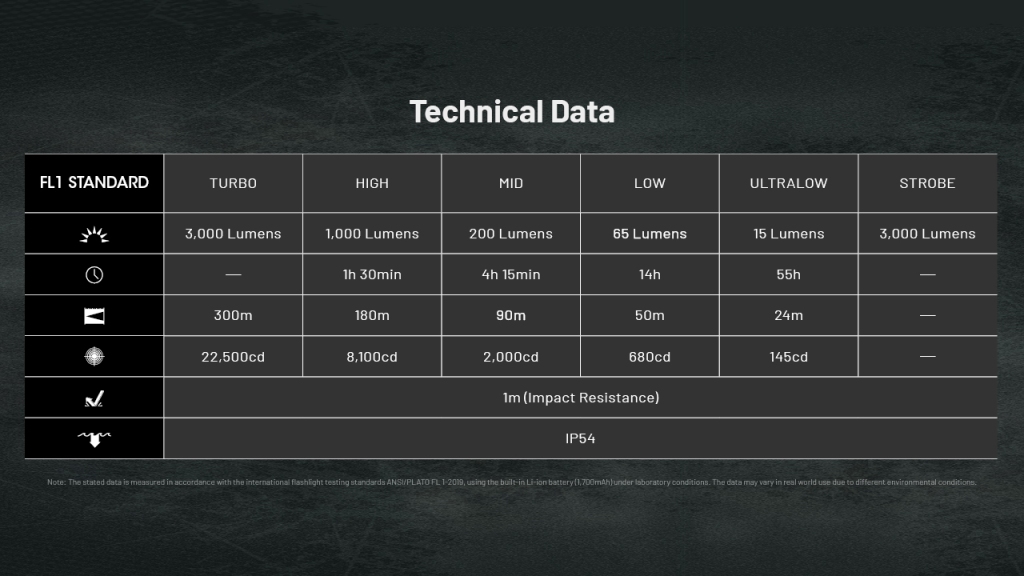
Above are the official specs, followed by my own measurements below.
| Level | Lumens | Candela | Throw (Meters) | CRI (Ra) | Color Temp. (K) | DUV (Tint) |
| Turbo | 2900 | 27000 | 329 | 67 | 6300 | 0.0062 |
| High | 1100 | 10241 | 202 | 61 | 5870 | 0.0132 |
| Medium | 230 | 2141 | 93 | 60 | 5550 | 0.0151 |
| Low | 68 | 633 | 50 | 60 | 5460 | 0.0157 |
| “Ultralow” | 15 | 140 | 24 | 59 | 5480 | 0.0169 |
Runtime
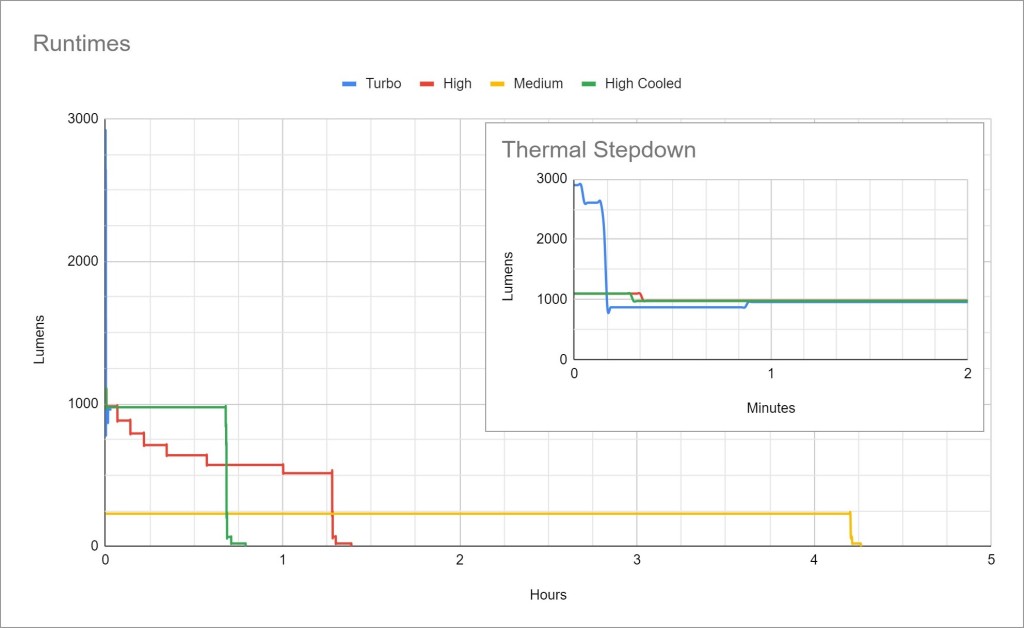
Performance is impressive. Turbo only lasts about 10 seconds, but I wouldn’t expect any more from a light so bright and so thin. Sustained brightness is above 500 lumens and High mode lasts around an hour depending on ambient temperature. Medium is perfectly flat at ~250 lumens for about four hours.
Thermal regulation is present and works well in High mode. Turbo mode is timed to step down at 10 seconds.
LVP (Low Voltage Protection): The light will shut off when the battery is effectively empty. It can be reactivated in an emergency.
Driver & Regulation
I don’t know what kind of driver is used here. My guess is it’s probably Buck+FET. FET Turbo and Buck for all the other modes.
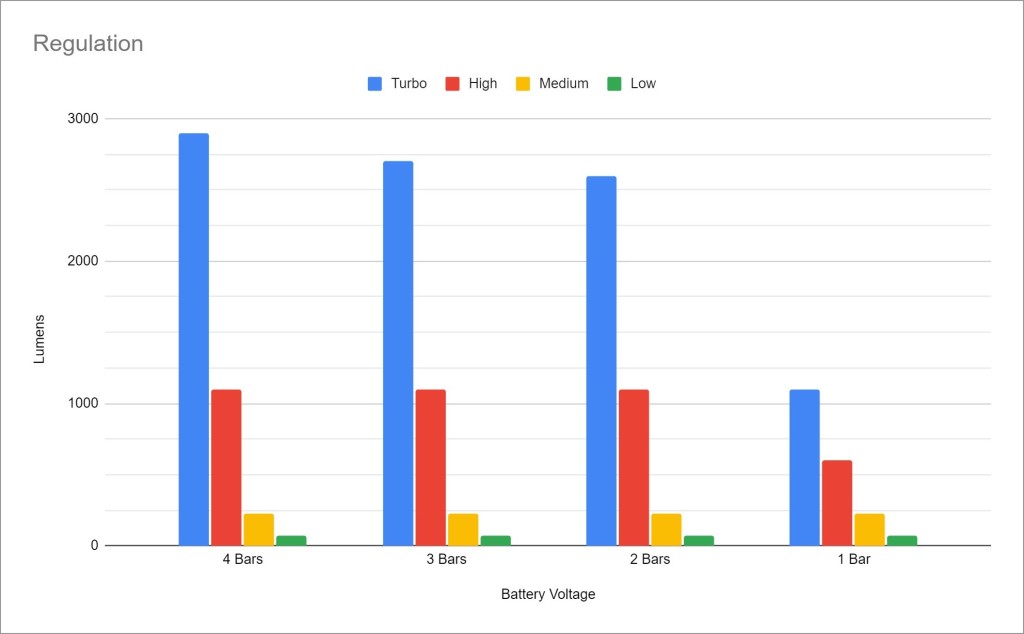
Regulation is unexpectedly good. Normally lights with such a high brightness-to-size ratio have abysmal regulation performance, but EDC25 can produce near full Turbo brightness until the battery reaches ~25% charge.
Note: All regulation measurements are taken at turn-on so they do not reflect any thermal or low voltage stepdowns that may occur. A value of 0 indicates low voltage shutoff immediately upon activation.
PWM: No PWM is visible to my eyes or camera, nor audible to my ears.
Parasitic Drain: I can’t measure parasitic drain because the battery is built in.
Switches

EDC25 has two switches. The larger, flat one is an e-switch that only controls momentary Turbo/Strobe. The smaller, prouder switch is a two-stage e-switch. It’s got two distinct clicks, one for a half-press and one for a full press. A full press turns the light on/off and a half press changes modes from on or activates Ultralow from off.
I love having the dedicated momentary Turbo/Strobe switch. The main two-stage switch works pretty well too.
Carry & Ergonomics
Ergonomics are fine. A reverse grip is most comfortable if you’re only using one of the switches. A cigar grip is most comfortable if you need access to both switches.
The clip works well enough but I don’t think it suits this light very well. It leaves a lot of the light sticking outside the pocket and there’s a big plastic piece above the clip for some reason that adds thickness. A simple deep carry clip would have been a better fit, I think. The clip screws don’t have any thread locker, so if you can find another clip that fits it’ll be easy to install. I included the screw spacing in the size and measurements section.
Batteries & Charging
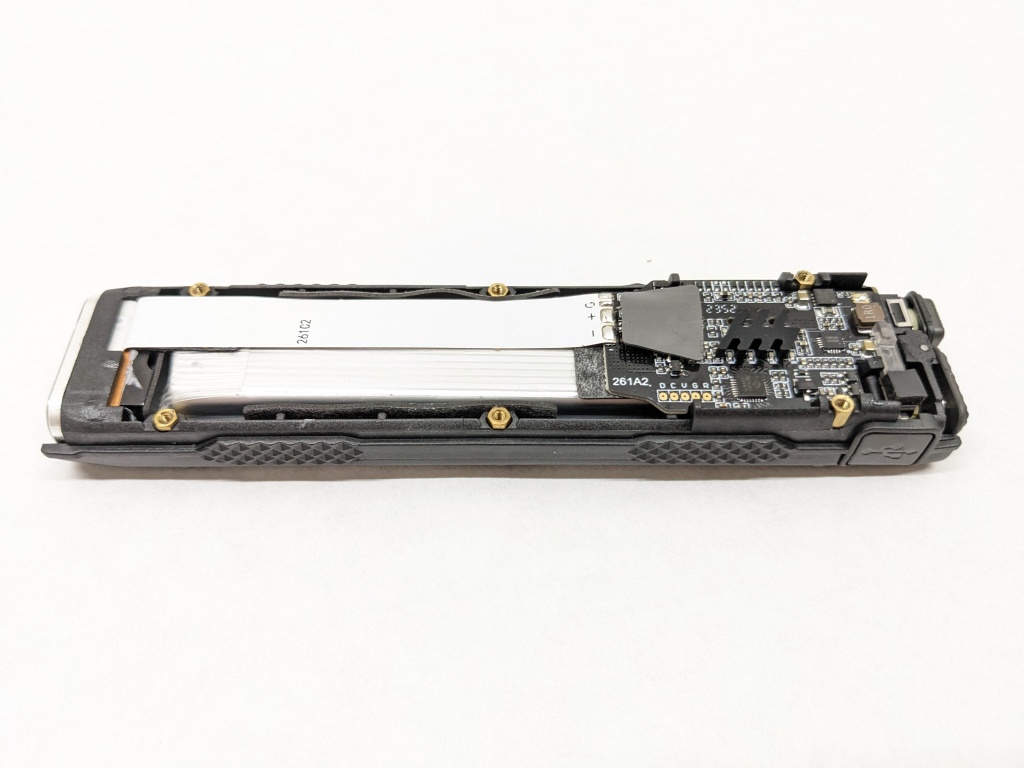
The battery is a built-in 1700mAh LiPo pouch cell. That’s smaller than I expected, but LiPo batteries pack a lot of punch. It’s not user-serviceable, so when the battery eventually wears out, you can’t replace it. That sucks, but it comes with the territory. All of these flat-style EDC lights have built-in batteries.
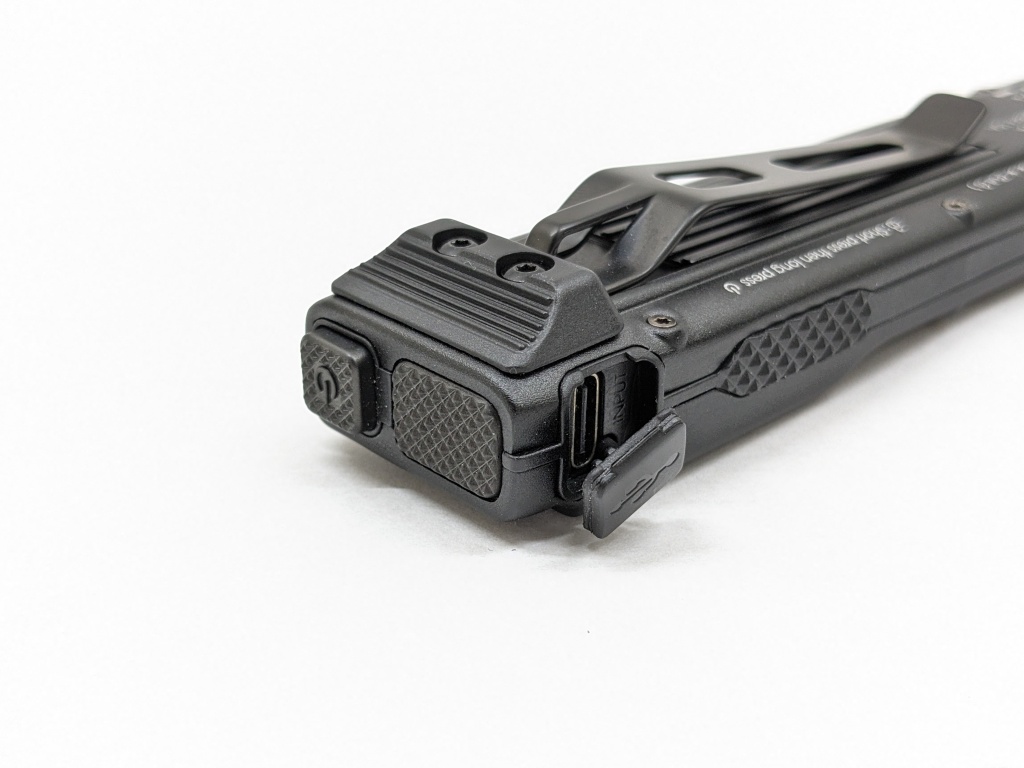
Charging is facilitated by a USB-C port on the side near the tail. It’s covered by a plastic and rubber port cover. Both A-to-C and C-to-C charging work fine. There’s no powerbank function, and I wouldn’t expect one with such a small battery. The light works while charging except for Turbo and Strobe.
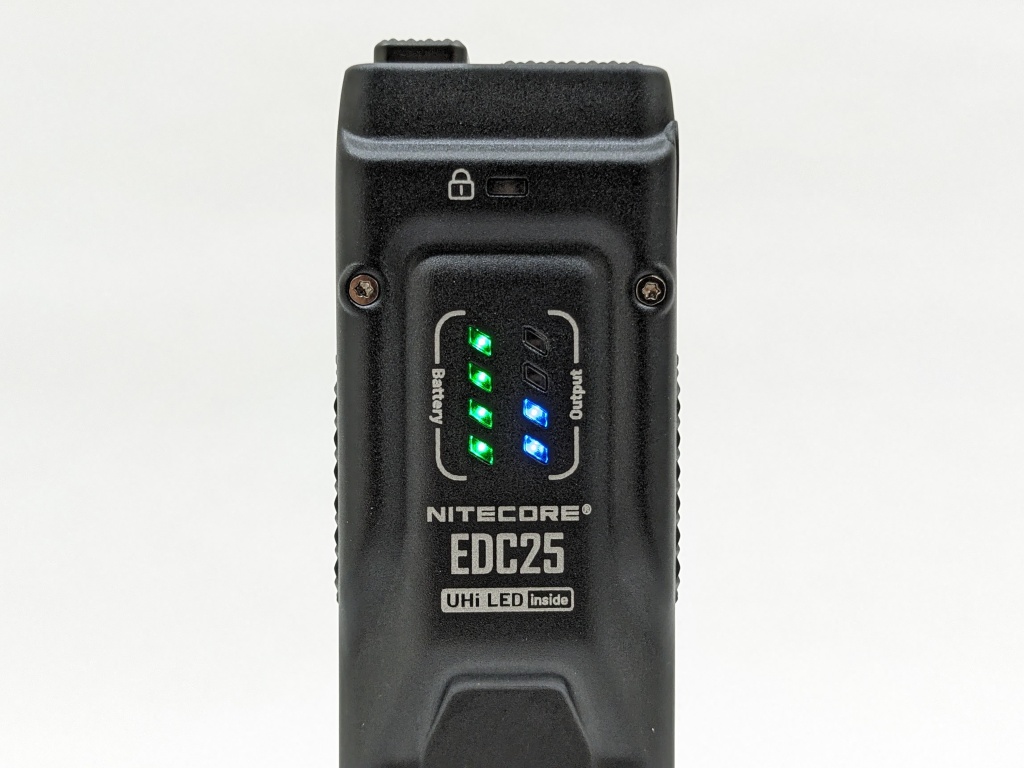
Battery indicators on the face of the light show charge status for a few seconds after a button is pressed or while the light is plugged in. There are four LEDs and each indicates 25% capacity. I love this style of battery indicator because it’s intuitive and glanceable. It’s dramatically easier to read than counting blinks for battery voltage.
Competition
Here are some lights in the same class and how they compare.
- more expensive
- less brightness and a lot less throw
- also has a green laser and UV
- side switch instead of dual tail switches
- convenient and proprietary magnetic charging
- smaller size
- better build quality
- difficult/impossible to remove pocket clip
- worse regulation performance
- a bit more expensive
- less brightness and throw
- neat OTF-knife-style switch
- only 2 modes
- slimmer and sleeker
- less expensive
- less brightness and throw
- also has a laser and a side RGBW light
- dual side switches instead of dual tail switches
- more expensive
- extremely similar design
- same switches and UI
- same brightness, worse throw
- gimmicky OLED display
- stamped steel construction instead of stamped aluminum (stronger but heavier)
This section is not comprehensive. If I didn’t include a particular light here, it doesn’t mean it’s bad or doesn’t deserve to be here. I simply cannot list every possible competitor.
Conclusion
I love the brightness, throw, battery indicators, USB-C charging, and dedicated Turbo switch. I like the rest of the UI, the main switch, the proximity sensor implementation, and the price tag. The build quality, aesthetics, and pocket clip are all fine. I don’t like the built-in battery, but it comes with the territory (all flat-style EDC lights like this).
The coolest thing about EDC25 is how it combines light weight, insane brightness, and tactical features in a flat-style EDC light. There’s nothing else on the market bringing all those features together. I think it’s more compelling than Nitecore’s EDC27 model too because it’s lighter, less expensive, throwier, and has a simpler/easier indicator system.
Thanks to Nitecore for sending me this light for review!
